 Highlights: Asus announces Android 9 Pie Beta program for its Zenfone Max Pro M1 smartphone. Max Pro M1 users can now enroll in the program to try it out. Asus recently published a list of its devices that are slated to receive the latest Android 9 Pie update this year. The Asus Zenfone Max Pro M1 was one of the handsets on the list and it seems like the company is making good on its promise. In a tweet, Asus announced that the Android Pie Beta Program is now official for the Max Pro M1 and users can now enrol and try out the beta build of the latest Android flavour. One can apply for the beta program here but should note that beta builds are usually buggy and are not recommended to be flashed on your daily driver. Additionally, on the beta program’s registration page, the company says it won’t provide downgrade service for beta power users, “unless beta power users would like to quit the beta user program.” One should also note that there are some requirements to participate in the Android Pie Beta program. One would, of course, need to own a ZenFone Max Pro M1 handset. They will also need to provide information that includes IMEI, Serial Number(SN), and the Current Firmware information for the beta test setting. The user needs to be used to the Android OS, which shouldn’t be a problem for an Android phone owner, and be able to read and provide feedback in English. Those who sign up for the Beta Power User Program will get to know if they are selected via email. Zenfone Max Pro M1 users, your craving for Pie ends now! We’re opening up the Android Beta Program to all those who wish to have an early taste of the Android Pie, while you wait for the official release. You may apply for the beta version by clicking here https://t.co/M2QHjSuajw pic.twitter.com/vpo5cGMD6w — ASUS India (@ASUSIndia) February 28, 2019 As we mentioned earlier, Asus has published a list of its devices that are slated to soon be updated to Android 9 Pie. It includes phones like the ROG Phone, the Asus Zenfone Max Pro M2, ZenFone 4 Selfie, ZenFone 4 Max and more. It should be noted that while the Zenfone 5Z and Max Pro M2 are included in the list, the two devices are already running on the latest Android Pie OS. The Zenfone 5Z is on the stable Android 9 Pie build while the beta Android Pie has been rolled out for the Max Pro M2. Related Reads: Asus ROG Phone, ZenFone Max Pro M1, Max Pro M2 and more Asus phones listed to receive Android 9 Pie update in 2019
Highlights: Asus announces Android 9 Pie Beta program for its Zenfone Max Pro M1 smartphone. Max Pro M1 users can now enroll in the program to try it out. Asus recently published a list of its devices that are slated to receive the latest Android 9 Pie update this year. The Asus Zenfone Max Pro M1 was one of the handsets on the list and it seems like the company is making good on its promise. In a tweet, Asus announced that the Android Pie Beta Program is now official for the Max Pro M1 and users can now enrol and try out the beta build of the latest Android flavour. One can apply for the beta program here but should note that beta builds are usually buggy and are not recommended to be flashed on your daily driver. Additionally, on the beta program’s registration page, the company says it won’t provide downgrade service for beta power users, “unless beta power users would like to quit the beta user program.” One should also note that there are some requirements to participate in the Android Pie Beta program. One would, of course, need to own a ZenFone Max Pro M1 handset. They will also need to provide information that includes IMEI, Serial Number(SN), and the Current Firmware information for the beta test setting. The user needs to be used to the Android OS, which shouldn’t be a problem for an Android phone owner, and be able to read and provide feedback in English. Those who sign up for the Beta Power User Program will get to know if they are selected via email. Zenfone Max Pro M1 users, your craving for Pie ends now! We’re opening up the Android Beta Program to all those who wish to have an early taste of the Android Pie, while you wait for the official release. You may apply for the beta version by clicking here https://t.co/M2QHjSuajw pic.twitter.com/vpo5cGMD6w — ASUS India (@ASUSIndia) February 28, 2019 As we mentioned earlier, Asus has published a list of its devices that are slated to soon be updated to Android 9 Pie. It includes phones like the ROG Phone, the Asus Zenfone Max Pro M2, ZenFone 4 Selfie, ZenFone 4 Max and more. It should be noted that while the Zenfone 5Z and Max Pro M2 are included in the list, the two devices are already running on the latest Android Pie OS. The Zenfone 5Z is on the stable Android 9 Pie build while the beta Android Pie has been rolled out for the Max Pro M2. Related Reads: Asus ROG Phone, ZenFone Max Pro M1, Max Pro M2 and more Asus phones listed to receive Android 9 Pie update in 2019from Latest Technology News https://ift.tt/2IHL09z
 Highlights: The Samsung Galaxy A90 could have a sliding and rotating camera It could look like a combination of the camera units seen on the Oppo N1 and Oppo Find X If you thought the slide-out camera on the Oppo Find X was cool, wait till you hear the new word on the street about the upcoming Samsung Galaxy A-series smartphone. According to the popular leakster @OnLeaks, the Samsung Galaxy A90 could come with a sliding and rotating camera system. In his tweet, he believes it will be a “kinda mix between Oppo Find X and Oppo N1 systems”, which means the camera module could slide out of the smartphone’s body and rotate to face either the user or the subject behind. As sophisticated as the new camera system may sound, its inclusion on Samsung’s upcoming model isn’t confirmed. The leakster claims to have heard about it from a “new and yet unconfirmed but seemingly reliable source”. So it’s probably best to take it with a hint of salt. On the other hand, given how smartphone manufacturers are currently on a quest to find the best way to maximise the screen-to-body ratio, there’s no reason for Samsung to drop out of the game. Samsung Galaxy A90 could hit a mark between the Oppo Find X (left) and the Oppo N1 (right) If Samsung does decide to go in for a sliding and rotating camera system, it would need to add that crucial (and usually expensive) moving mechanical part. We imagine the moving module will consist of a two- or even three-camera setup that resembles the rotating unit on the Oppo N1. The big advantage will be the reduction in number of cameras needed as the same set of cameras can be used for front and rear photography. But what Samsung saves in the reduction of cameras it will lose in making the sliding, rotating unit. This new rumour about the Galaxy A90 comes a day after the launch of Samsung’s first set of Galaxy A-series smartphones in India. Samsung’s new models include the low-end Galaxy A10 (priced at Rs 8,490), the mid-range Galaxy A30 (priced at Rs 16,990) and the upper mid-range Galaxy A50 (priced at Rs 19,990). The three new Galaxy A-series smartphones are set to go on sale in the market tomorrow. Related Read: Samsung Galaxy A10, Galaxy A30, Galaxy A50 launched in India According to new and yet unconfirmed but seemingly reliable source, #Samsung #GalaxyA90 will come with a sliding and rotating camera system (kinda mix between Oppo Find X and Oppo N1 systems) which allows the camera to be used as front and rear camera depending its position... pic.twitter.com/A6NBRzFFvK — Steve H.McFly (@OnLeaks) 27 February 2019
Highlights: The Samsung Galaxy A90 could have a sliding and rotating camera It could look like a combination of the camera units seen on the Oppo N1 and Oppo Find X If you thought the slide-out camera on the Oppo Find X was cool, wait till you hear the new word on the street about the upcoming Samsung Galaxy A-series smartphone. According to the popular leakster @OnLeaks, the Samsung Galaxy A90 could come with a sliding and rotating camera system. In his tweet, he believes it will be a “kinda mix between Oppo Find X and Oppo N1 systems”, which means the camera module could slide out of the smartphone’s body and rotate to face either the user or the subject behind. As sophisticated as the new camera system may sound, its inclusion on Samsung’s upcoming model isn’t confirmed. The leakster claims to have heard about it from a “new and yet unconfirmed but seemingly reliable source”. So it’s probably best to take it with a hint of salt. On the other hand, given how smartphone manufacturers are currently on a quest to find the best way to maximise the screen-to-body ratio, there’s no reason for Samsung to drop out of the game. Samsung Galaxy A90 could hit a mark between the Oppo Find X (left) and the Oppo N1 (right) If Samsung does decide to go in for a sliding and rotating camera system, it would need to add that crucial (and usually expensive) moving mechanical part. We imagine the moving module will consist of a two- or even three-camera setup that resembles the rotating unit on the Oppo N1. The big advantage will be the reduction in number of cameras needed as the same set of cameras can be used for front and rear photography. But what Samsung saves in the reduction of cameras it will lose in making the sliding, rotating unit. This new rumour about the Galaxy A90 comes a day after the launch of Samsung’s first set of Galaxy A-series smartphones in India. Samsung’s new models include the low-end Galaxy A10 (priced at Rs 8,490), the mid-range Galaxy A30 (priced at Rs 16,990) and the upper mid-range Galaxy A50 (priced at Rs 19,990). The three new Galaxy A-series smartphones are set to go on sale in the market tomorrow. Related Read: Samsung Galaxy A10, Galaxy A30, Galaxy A50 launched in India According to new and yet unconfirmed but seemingly reliable source, #Samsung #GalaxyA90 will come with a sliding and rotating camera system (kinda mix between Oppo Find X and Oppo N1 systems) which allows the camera to be used as front and rear camera depending its position... pic.twitter.com/A6NBRzFFvK — Steve H.McFly (@OnLeaks) 27 February 2019  Highlights; Motorola's foldable smartphone could look like the iconic RAZR V3 from the 2000s Motorola might even pursue a dual-hinge design Big players in the smartphone industry like Samsung and Huawei have been busy showcasing their foldable smartphones at this year’s Mobile World Congress in Barcelona, while Motorola has been keeping silent. Now, however, a new interview by Engadget reveals that Motorola is indeed actively working on its first foldable smartphone and that the Lenovo-owned company could launch it sometime before the year ends. More importantly, the interview suggests that Motorola’s upcoming foldable smartphone could resemble the RAZR, the popular clamshell phone from the 2000s. Renders published by Engadget reveal a RAZR-like design in that the phone folds shut like a traditional clamshell handset but opens up to show a vertical folding touchscreen with a tall aspect ratio on the inside. There is, of course, that famous RAZR chin at the bottom, which could house essential electronics including a USB Type-C port. On the outside, the device has a small squarish display, which might be a touchscreen that could enable users to perform some basic functions. For all we know, Motorola might even go in for a dual-hinge design, where the same single screen folds twice. Referring to a design that’s similar to the one seen on the Huawei Mate X, Dan Dery, the Vice President of Global Product at Motorola commented, “The fact that you're touching [that kind of display] with your nails is scratching it. It has a short life right away; it starts dying the day you unpack it. But it's beautiful. That first day, it's beautiful.” When asked if Motorola would go in for a Z-shaped hinge design, Dery denied and said that it just wouldn’t be a design practical enough for Motorola to pursue while designing its very first foldable smartphone. If Motorola’s first foldable smartphone is actually designed like the original RAZR and branded similarly, fans are bound to be excited. To refresh your memory, the original Motorola RAZR V3 was first announced in 2004. It had a 2.2-inch 9-line TFT display with a resolution of 176 x 220 pixels on the inside. The battery on it was a removable 680mAh unit. It went on to become one of Motorola’s most iconic phone designs. We can expect Motorola’s first foldable smartphone sometime later this year. Cover image courtesy: Engadget Related Read: Samsung Galaxy Fold unfolded in a 4-minute long video
Highlights; Motorola's foldable smartphone could look like the iconic RAZR V3 from the 2000s Motorola might even pursue a dual-hinge design Big players in the smartphone industry like Samsung and Huawei have been busy showcasing their foldable smartphones at this year’s Mobile World Congress in Barcelona, while Motorola has been keeping silent. Now, however, a new interview by Engadget reveals that Motorola is indeed actively working on its first foldable smartphone and that the Lenovo-owned company could launch it sometime before the year ends. More importantly, the interview suggests that Motorola’s upcoming foldable smartphone could resemble the RAZR, the popular clamshell phone from the 2000s. Renders published by Engadget reveal a RAZR-like design in that the phone folds shut like a traditional clamshell handset but opens up to show a vertical folding touchscreen with a tall aspect ratio on the inside. There is, of course, that famous RAZR chin at the bottom, which could house essential electronics including a USB Type-C port. On the outside, the device has a small squarish display, which might be a touchscreen that could enable users to perform some basic functions. For all we know, Motorola might even go in for a dual-hinge design, where the same single screen folds twice. Referring to a design that’s similar to the one seen on the Huawei Mate X, Dan Dery, the Vice President of Global Product at Motorola commented, “The fact that you're touching [that kind of display] with your nails is scratching it. It has a short life right away; it starts dying the day you unpack it. But it's beautiful. That first day, it's beautiful.” When asked if Motorola would go in for a Z-shaped hinge design, Dery denied and said that it just wouldn’t be a design practical enough for Motorola to pursue while designing its very first foldable smartphone. If Motorola’s first foldable smartphone is actually designed like the original RAZR and branded similarly, fans are bound to be excited. To refresh your memory, the original Motorola RAZR V3 was first announced in 2004. It had a 2.2-inch 9-line TFT display with a resolution of 176 x 220 pixels on the inside. The battery on it was a removable 680mAh unit. It went on to become one of Motorola’s most iconic phone designs. We can expect Motorola’s first foldable smartphone sometime later this year. Cover image courtesy: Engadget Related Read: Samsung Galaxy Fold unfolded in a 4-minute long video Highlights: Asus lists its phones that will receive Android 9 Pie update this year. The Asus ROG Phone, Asus Max Pro M1, Max Pro M2 and many others make the cut. There is no specific detail about the update like when it will be rolled out for the phones. Asus has a wide smartphone portfolio in India, with the ROG Phone being the latest added to the lineup. The company has now revealed the name of its phones that will be receiving the Android 9 Pie update and as expected, the ROG phone is on it. Alongside the company’s gaming-centric smartphone, the listing also includes the Zenfone 5Z, Zenfone Max Pro M1, Max Pro M2, and some older phones. However, the company has not provided any specifics, like a date, about when exactly will these handsets be updated. The news comes via the company’s official forum where a forum moderator posted the list. All the Asus phones that will be updated to Android 9 Pie this year are listed below. Do note that while the Zenfone 5Z and Max Pro M2 are included in the list, the two devices are already running on the latest Android flavour. The Zenfone 5Z is on the stable Android 9 Pie build while the beta Android Pie has been rolled out for the Max Pro M2. ZenFone 4 Max (ZC554KL) ZenFone 4 Selfie (ZD553KL) ZenFone 4 Max (ZC520KL) ZenFone Live (ZB553KL) ZenFone4 Max (ZB520KL) ZenFone Max Plus (M1) Clear Soft Bumper (ZB570TL) ZenFone 5Q (ZC600KL) ZenFone Live (L1) Clear Soft Bumper (ZA550KZ / ZA551KL) ZenFone Max Pro (ZB602KL) ZenFone Max Pro (ZB601KL) ZenFone Max (M1) Clear Soft Bumper (ZB555KL / ZB556KL) ZenFone 5 (ZE620KL) ZenFone 5Z (ZS620KL) ASUS ROG Phone (ZS600KL) ZenFone Max Pro (M2) Clear Soft Bumper (ZB631KL/ ZB630KL) ZenFone Max (M2) Clear Soft Bumper (ZB633KL / ZB632KL) Speaking of the Android 9 Pie upgrade, other phone makers are also rushing to roll out the update for their respective handsets. Nokia recently announced that its entry-level Nokia 3.1 smartphone is now receiving the Android 9 Pie update, along with the Nokia 2.1, which being an Android Go device received the Android 9 Pie (Go Edition) update. The Samsung Galaxy Note 8 has also received Android Pie based One UI update in India. Related Reads: Nokia 3.1 Plus now receiving Android 9 Pie Nokia 2.1 gets February security patch, up to 500MB additional storage with Android 9 Pie (Go Edition) update
Highlights: Asus lists its phones that will receive Android 9 Pie update this year. The Asus ROG Phone, Asus Max Pro M1, Max Pro M2 and many others make the cut. There is no specific detail about the update like when it will be rolled out for the phones. Asus has a wide smartphone portfolio in India, with the ROG Phone being the latest added to the lineup. The company has now revealed the name of its phones that will be receiving the Android 9 Pie update and as expected, the ROG phone is on it. Alongside the company’s gaming-centric smartphone, the listing also includes the Zenfone 5Z, Zenfone Max Pro M1, Max Pro M2, and some older phones. However, the company has not provided any specifics, like a date, about when exactly will these handsets be updated. The news comes via the company’s official forum where a forum moderator posted the list. All the Asus phones that will be updated to Android 9 Pie this year are listed below. Do note that while the Zenfone 5Z and Max Pro M2 are included in the list, the two devices are already running on the latest Android flavour. The Zenfone 5Z is on the stable Android 9 Pie build while the beta Android Pie has been rolled out for the Max Pro M2. ZenFone 4 Max (ZC554KL) ZenFone 4 Selfie (ZD553KL) ZenFone 4 Max (ZC520KL) ZenFone Live (ZB553KL) ZenFone4 Max (ZB520KL) ZenFone Max Plus (M1) Clear Soft Bumper (ZB570TL) ZenFone 5Q (ZC600KL) ZenFone Live (L1) Clear Soft Bumper (ZA550KZ / ZA551KL) ZenFone Max Pro (ZB602KL) ZenFone Max Pro (ZB601KL) ZenFone Max (M1) Clear Soft Bumper (ZB555KL / ZB556KL) ZenFone 5 (ZE620KL) ZenFone 5Z (ZS620KL) ASUS ROG Phone (ZS600KL) ZenFone Max Pro (M2) Clear Soft Bumper (ZB631KL/ ZB630KL) ZenFone Max (M2) Clear Soft Bumper (ZB633KL / ZB632KL) Speaking of the Android 9 Pie upgrade, other phone makers are also rushing to roll out the update for their respective handsets. Nokia recently announced that its entry-level Nokia 3.1 smartphone is now receiving the Android 9 Pie update, along with the Nokia 2.1, which being an Android Go device received the Android 9 Pie (Go Edition) update. The Samsung Galaxy Note 8 has also received Android Pie based One UI update in India. Related Reads: Nokia 3.1 Plus now receiving Android 9 Pie Nokia 2.1 gets February security patch, up to 500MB additional storage with Android 9 Pie (Go Edition) update 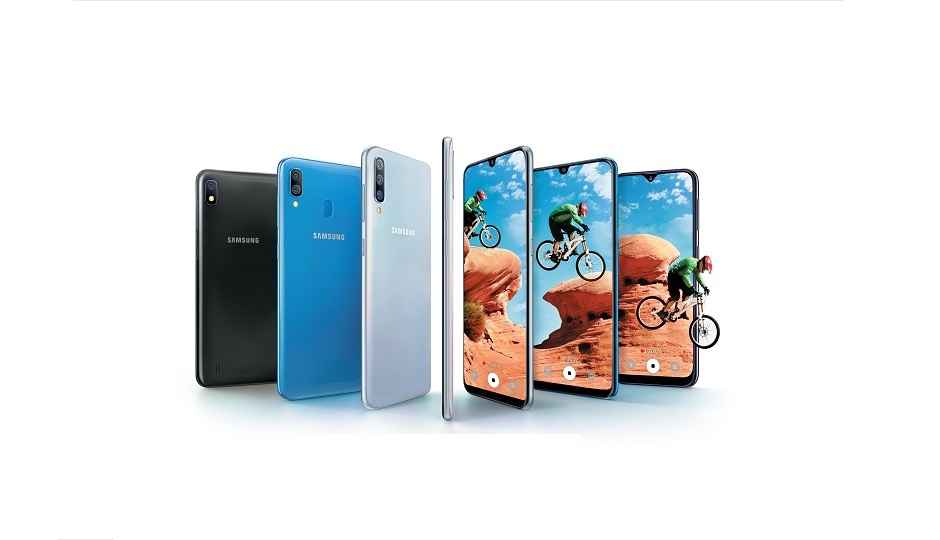 Highlights: Samsung Galaxy A10, Galaxy A30 and Galaxy A50 smartphones launched in India. The Galaxy A10 and the Galaxy A30 are priced at Rs 8,490 and Rs 16,990 respectively. The Galaxy A50 starts at Rs 19,990. Samsung has launched three new smartphones in the entry-level and mid-range segments, under its Galaxy A-series brand. The three new models are the Galaxy A10, Galaxy A30, and Galaxy A50, which are priced starting at Rs 8,490, Rs 16,990, and Rs 19,990 respectively. While the Galaxy A30 and Galaxy A50 come with what the company calls an Infinity-U display, the cheaper Galaxy A10 sports an Infinity-V display design. All three models will go on sale in India from March 2. Galaxy A10 The Galaxy A10 is the entry-level model among the three new A-series phones. It has a 6.2-inch HD+ Infinity-V display, which means the tiny notch on the top of the display is V-shaped. For optics, it gets a single 13-megapixel rear camera with an f/1.9 aperture along with a 5-megapixel selfie camera in the front, which supports face recognition. It's powered by an Exynos 7884 chipset and up to 3GB of RAM. The battery on it is a 3,400mAh unit. When on sale, the Galaxy A10 will be available in red, blue, and black colours. Galaxy A30 The Galaxy A30 sits between the Galaxy A10 and the Galaxy A50 in Samsung’s new Galaxy A series. The smartphone features a 6.4-inch Super AMOLED Infinity-U display, which means the little notch on top of the display is U-shaped. It’s equipped with a fingerprint scanner on the back and a 4,000mAh battery, which is juiced up using a 15W fast charging technology. Optics are taken care of by a dual camera setup on the back (16-megapixel camera with an f/1.7 aperture and a 5-megapixel camera with an f/2.2 aperture), including a wide-angle lens. The Galaxy A30 is powered by an Exynos 7904 chipset with an octa-core processor and 4GB of RAM. When launched, the Galaxy A30 will be available in red, blue, and black colours. Galaxy A50 The Galaxy A50 is the top-most variant of the three models here. It comes equipped with a 6.4-inch Full HD+ Super AMOLED Infinity-U display, which according to Samsung, allows for a 91.6-percent screen-to-body ratio. It is equipped with a triple camera on the back: an 8-megapixel ultra-wide lens with a 123-degree field of view, a 25-megapixel main camera with an f/1.7 aperture, and a 5-megapixel depth sensor with an f/2.2 aperture. The smartphone uses Samsung’s Intelligent Scene Optimizer to adjust contrast, brightness, and colour optimally. The Galaxy A50 is powered by an Exynos 9610 chipset with an octa-core processor and up to 6GB of RAM. The fingerprint scanner is found under the display. The battery on the handset is a 4,000mAh unit with 15W fast charging capability (through USB Type-C). When launched, the Galaxy A50 will be launched in blue, black, and white colours and 64GB of internal storage. The Galaxy A50 will be available in two variants: a 4GB RAM variant, priced at Rs 19,990 and a 6GB RAM, priced at Rs 22,990. All three models will go on sale starting March 2. Related Read: Redmi Note 7 Pro with 48MP camera launched in India alongside Redmi Note 7: Price, Specs, and all you need to know
Highlights: Samsung Galaxy A10, Galaxy A30 and Galaxy A50 smartphones launched in India. The Galaxy A10 and the Galaxy A30 are priced at Rs 8,490 and Rs 16,990 respectively. The Galaxy A50 starts at Rs 19,990. Samsung has launched three new smartphones in the entry-level and mid-range segments, under its Galaxy A-series brand. The three new models are the Galaxy A10, Galaxy A30, and Galaxy A50, which are priced starting at Rs 8,490, Rs 16,990, and Rs 19,990 respectively. While the Galaxy A30 and Galaxy A50 come with what the company calls an Infinity-U display, the cheaper Galaxy A10 sports an Infinity-V display design. All three models will go on sale in India from March 2. Galaxy A10 The Galaxy A10 is the entry-level model among the three new A-series phones. It has a 6.2-inch HD+ Infinity-V display, which means the tiny notch on the top of the display is V-shaped. For optics, it gets a single 13-megapixel rear camera with an f/1.9 aperture along with a 5-megapixel selfie camera in the front, which supports face recognition. It's powered by an Exynos 7884 chipset and up to 3GB of RAM. The battery on it is a 3,400mAh unit. When on sale, the Galaxy A10 will be available in red, blue, and black colours. Galaxy A30 The Galaxy A30 sits between the Galaxy A10 and the Galaxy A50 in Samsung’s new Galaxy A series. The smartphone features a 6.4-inch Super AMOLED Infinity-U display, which means the little notch on top of the display is U-shaped. It’s equipped with a fingerprint scanner on the back and a 4,000mAh battery, which is juiced up using a 15W fast charging technology. Optics are taken care of by a dual camera setup on the back (16-megapixel camera with an f/1.7 aperture and a 5-megapixel camera with an f/2.2 aperture), including a wide-angle lens. The Galaxy A30 is powered by an Exynos 7904 chipset with an octa-core processor and 4GB of RAM. When launched, the Galaxy A30 will be available in red, blue, and black colours. Galaxy A50 The Galaxy A50 is the top-most variant of the three models here. It comes equipped with a 6.4-inch Full HD+ Super AMOLED Infinity-U display, which according to Samsung, allows for a 91.6-percent screen-to-body ratio. It is equipped with a triple camera on the back: an 8-megapixel ultra-wide lens with a 123-degree field of view, a 25-megapixel main camera with an f/1.7 aperture, and a 5-megapixel depth sensor with an f/2.2 aperture. The smartphone uses Samsung’s Intelligent Scene Optimizer to adjust contrast, brightness, and colour optimally. The Galaxy A50 is powered by an Exynos 9610 chipset with an octa-core processor and up to 6GB of RAM. The fingerprint scanner is found under the display. The battery on the handset is a 4,000mAh unit with 15W fast charging capability (through USB Type-C). When launched, the Galaxy A50 will be launched in blue, black, and white colours and 64GB of internal storage. The Galaxy A50 will be available in two variants: a 4GB RAM variant, priced at Rs 19,990 and a 6GB RAM, priced at Rs 22,990. All three models will go on sale starting March 2. Related Read: Redmi Note 7 Pro with 48MP camera launched in India alongside Redmi Note 7: Price, Specs, and all you need to know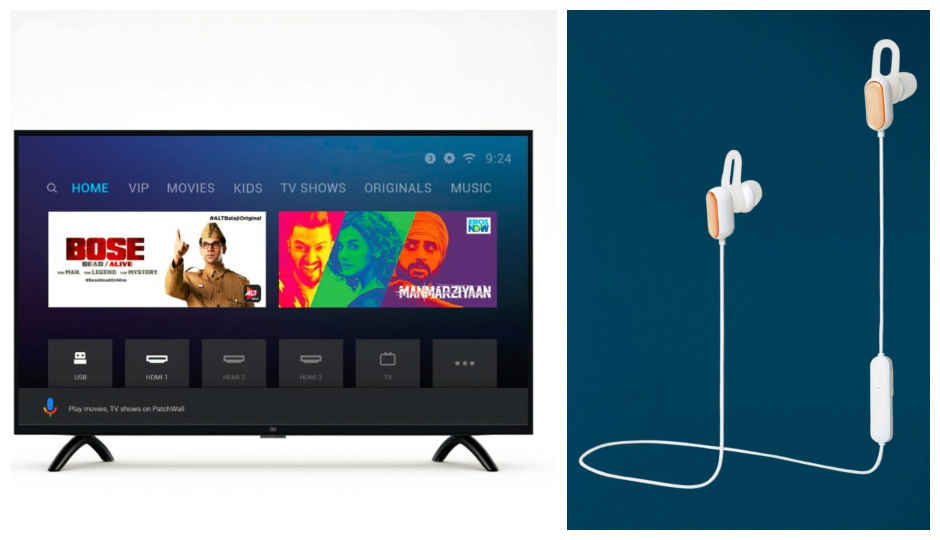 Highlights: Mi LED TV 4A PRO launched in India at Rs 12,999. Xiaomi also announced the Mi Sports Bluetooth Earphones Basic that is priced at Rs 1,499 It’s been a busy day for Xiaomi today. It just launched two long-awaited smartphones, the Redmi Note 7 and the Redmi Note 7 Pro at a starting price of Rs 9,999 and Rs 13,999 respectively. But that’s not all. The Chinese electronics manufacturer also launched the Mi Sports Bluetooth Earphones Basic at Rs 1,499 and the 32-inch Mi LED TV 4A PRO at Rs 12,999. Pre-orders for the earphones start on Mi.com from today, while the TV will be available from March 7 at noon on Mi.com, Mi Home, and Flipkart. The Mi Sports Earphones Basic is a pair of splashproof wireless earphones. More specifically, they are IPX4 rated for resistance against water splashes and sweat. Xiaomi claims they can deliver a battery life of 7 hours on a single charge. The company also says they feature enhanced bass response and come with an in-line microphone, along with buttons to control audio playback. What’s more, they come with Google Assistant support. Xiaomi will sell the Mi Sports Earphones Basic for Rs 1,499. Coming to the Mi LED TV 4A PRO, it is a 32-inch LED smart television with an HD Ready resolution (1280 x 720 pixels). It sports 20W speakers with support for DTS HD audio and runs on the PatchWall, Mi’s proprietary OS, that is said to comes with access to over 7,00,000 hours of content. It also supports Android TV, which means it gets Google Play, inbuilt Chromecast support, YouTube, and Google Assistant. The Mi LED TV 4A PRO is priced at Rs 12,999. These two products were launched along with the Redmi Note 7 and the Redmi Note 7 Pro smartphones. The Redmi Note 7 is powered by a Qualcomm Snapdragon 660 chipset and up to 4GB of RAM, while the larger and more expensive Redmi Note 7 Pro is powered by a Qualcomm Snapdragon 675 chipset and up to 6GB of RAM. Both phones have a 6.3-inch Full HD+ display with Corning Gorilla Glass 5 protection and a “Dot Notch” for the selfie camera. Related Read: Redmi Note 7 Pro with 48MP camera launched in India alongside Redmi Note 7: Price, Specs, and all you need to know Here’s another BIG thing you guys have been waiting for. The #MiSportsBluetoothEarphonesBasic : - 9 hrs long battery life - Dynamic bass - IPX4 splash & sweat proof - Secure-fit design - Works with Google Assistant Pre-order starts today on https://t.co/cwYEXeds6Y at ₹1,499. pic.twitter.com/uibdtzFzFW — Redmi India (@RedmiIndia) February 28, 2019
Highlights: Mi LED TV 4A PRO launched in India at Rs 12,999. Xiaomi also announced the Mi Sports Bluetooth Earphones Basic that is priced at Rs 1,499 It’s been a busy day for Xiaomi today. It just launched two long-awaited smartphones, the Redmi Note 7 and the Redmi Note 7 Pro at a starting price of Rs 9,999 and Rs 13,999 respectively. But that’s not all. The Chinese electronics manufacturer also launched the Mi Sports Bluetooth Earphones Basic at Rs 1,499 and the 32-inch Mi LED TV 4A PRO at Rs 12,999. Pre-orders for the earphones start on Mi.com from today, while the TV will be available from March 7 at noon on Mi.com, Mi Home, and Flipkart. The Mi Sports Earphones Basic is a pair of splashproof wireless earphones. More specifically, they are IPX4 rated for resistance against water splashes and sweat. Xiaomi claims they can deliver a battery life of 7 hours on a single charge. The company also says they feature enhanced bass response and come with an in-line microphone, along with buttons to control audio playback. What’s more, they come with Google Assistant support. Xiaomi will sell the Mi Sports Earphones Basic for Rs 1,499. Coming to the Mi LED TV 4A PRO, it is a 32-inch LED smart television with an HD Ready resolution (1280 x 720 pixels). It sports 20W speakers with support for DTS HD audio and runs on the PatchWall, Mi’s proprietary OS, that is said to comes with access to over 7,00,000 hours of content. It also supports Android TV, which means it gets Google Play, inbuilt Chromecast support, YouTube, and Google Assistant. The Mi LED TV 4A PRO is priced at Rs 12,999. These two products were launched along with the Redmi Note 7 and the Redmi Note 7 Pro smartphones. The Redmi Note 7 is powered by a Qualcomm Snapdragon 660 chipset and up to 4GB of RAM, while the larger and more expensive Redmi Note 7 Pro is powered by a Qualcomm Snapdragon 675 chipset and up to 6GB of RAM. Both phones have a 6.3-inch Full HD+ display with Corning Gorilla Glass 5 protection and a “Dot Notch” for the selfie camera. Related Read: Redmi Note 7 Pro with 48MP camera launched in India alongside Redmi Note 7: Price, Specs, and all you need to know Here’s another BIG thing you guys have been waiting for. The #MiSportsBluetoothEarphonesBasic : - 9 hrs long battery life - Dynamic bass - IPX4 splash & sweat proof - Secure-fit design - Works with Google Assistant Pre-order starts today on https://t.co/cwYEXeds6Y at ₹1,499. pic.twitter.com/uibdtzFzFW — Redmi India (@RedmiIndia) February 28, 2019 Highlights: Redmi Note 7 Pro launched in India along with the Redmi Note 7. After teasing the Redmi Note 7 for Xiaomi has finally launched the smartphone in India, along with the Redmi Note 7 Pro. In India, the company decided to make a global debut of the Redmi Note 7 Pro, which packs a 48MP Sony IMX586 sensor. While the Redmi Note 7 that was previously announced in China featured a 48MP Samsung G1 sensor, the company has changed the optics of the device for India. It now gets a 12MP primary sensor instead of the 48MP Samsung sensor. Redmi Note 7 Pro Specifications The phone features Aura Design, which is said to deliver immersive experience with thinner bezels. It features a 6.3-inch Full HD+ LTPS screen with a 19.5:9 waterdrop notch display design. The company says it has managed to incorporate a larger display in the same form factor. Features like Sunlight Display that boosts brightness and contrast, and Reading Mode which adjusts colour temperature to cut down on blue light are also present. The smartphone is powered by the new Qualcomm Snapdragon 675 SoC octa-core processor and comes with up to 6GB RAM and up to 128GB storage. As the company had earlier revealed, the Redmi Note 7 Pro comes equipped with a 48MP main rear camera, which is supplemented with a 5MP secondary sensor. It comes equipped with the Sony IMX586 sensor. The Sony sensor is a half-inch stacked CMOS sensor, which is touted to deliver better images in low-light. The primary camera features an f/1.79 aperture lens. The company says that by default, the Redmi Note 7’s camera captures 12MP images and to click an image in 48MP, one will need to navigate to Pro mode in the camera app. The camera can also detect from 33 scenes with AI scene detection and comes with AI portrait 2.0 that is said to enable adjustable bokeh, studio lighting and light trails features. The phone supports capturing 4K videos at 30fps and comes with EIS. On the front, the Note 7 Pro is equipped with a 13MP camera that also enables face unlock. The Redmi Note 7 Pro is protected by Gorilla Glass 5 display on both the front and the back and comes equipped with a Type-C port. It runs on MIUI 10 based on Android 9 Pie and is backed by a 4000mAh battery that supports Qualcomm Quick Charge 4. While the device supports 18W fast charging, one will get a 10W charger in the box. Redmi Note 7 Specifications We know almost everything there is to know about the Redmi Note 7 as it went official in China about a month ago. It is powered by a Qualcomm Snapdragon 660 SoC and is comes in three variants. It will be available in 3/32GB, 4/64GB and 6/64GB memory and storage variants. The handset sports a 6.3-inch LCD display that is protected by a Gorilla Glass 5 on top. It also features a 19.5:9 display aspect ratio and gets a waterdrop notch design. In terms of optics, the smartphone features a 12MP + 2MP dual rear camera setup. The company has apparently decided to ditch the 48MP Samsung GM-1 sensor, which can be found on the Redmi Note 7 that sells in China. The 12MP primary sensor has a 1.25µm pixel pitch, while the 5MP secondary camera helps in capturing bokeh images. On the front, it sports a 13MP sensor that supports AI portrait selfie, along with the face unlock feature. The phone also packs a 4,000mAh battery and like its more powerful sibling, supports Quick Charge 4.0. Redmi Note 7 Pro, Note 7 Price and Availability The Redmi Note 7 Pro comes in Neptune Blue, Nebula Red and Space Black colour variants. Its 4GB RAM, 64GB storage version is priced at Rs 13,999, while the 6GB RAM/128GB storage variant will cost Rs 16,999. The Redmi Note 7 will be available in Onyx Black, Ruby Red and the Sapphire Blue colour variants. Developing....
Highlights: Redmi Note 7 Pro launched in India along with the Redmi Note 7. After teasing the Redmi Note 7 for Xiaomi has finally launched the smartphone in India, along with the Redmi Note 7 Pro. In India, the company decided to make a global debut of the Redmi Note 7 Pro, which packs a 48MP Sony IMX586 sensor. While the Redmi Note 7 that was previously announced in China featured a 48MP Samsung G1 sensor, the company has changed the optics of the device for India. It now gets a 12MP primary sensor instead of the 48MP Samsung sensor. Redmi Note 7 Pro Specifications The phone features Aura Design, which is said to deliver immersive experience with thinner bezels. It features a 6.3-inch Full HD+ LTPS screen with a 19.5:9 waterdrop notch display design. The company says it has managed to incorporate a larger display in the same form factor. Features like Sunlight Display that boosts brightness and contrast, and Reading Mode which adjusts colour temperature to cut down on blue light are also present. The smartphone is powered by the new Qualcomm Snapdragon 675 SoC octa-core processor and comes with up to 6GB RAM and up to 128GB storage. As the company had earlier revealed, the Redmi Note 7 Pro comes equipped with a 48MP main rear camera, which is supplemented with a 5MP secondary sensor. It comes equipped with the Sony IMX586 sensor. The Sony sensor is a half-inch stacked CMOS sensor, which is touted to deliver better images in low-light. The primary camera features an f/1.79 aperture lens. The company says that by default, the Redmi Note 7’s camera captures 12MP images and to click an image in 48MP, one will need to navigate to Pro mode in the camera app. The camera can also detect from 33 scenes with AI scene detection and comes with AI portrait 2.0 that is said to enable adjustable bokeh, studio lighting and light trails features. The phone supports capturing 4K videos at 30fps and comes with EIS. On the front, the Note 7 Pro is equipped with a 13MP camera that also enables face unlock. The Redmi Note 7 Pro is protected by Gorilla Glass 5 display on both the front and the back and comes equipped with a Type-C port. It runs on MIUI 10 based on Android 9 Pie and is backed by a 4000mAh battery that supports Qualcomm Quick Charge 4. While the device supports 18W fast charging, one will get a 10W charger in the box. Redmi Note 7 Specifications We know almost everything there is to know about the Redmi Note 7 as it went official in China about a month ago. It is powered by a Qualcomm Snapdragon 660 SoC and is comes in three variants. It will be available in 3/32GB, 4/64GB and 6/64GB memory and storage variants. The handset sports a 6.3-inch LCD display that is protected by a Gorilla Glass 5 on top. It also features a 19.5:9 display aspect ratio and gets a waterdrop notch design. In terms of optics, the smartphone features a 12MP + 2MP dual rear camera setup. The company has apparently decided to ditch the 48MP Samsung GM-1 sensor, which can be found on the Redmi Note 7 that sells in China. The 12MP primary sensor has a 1.25µm pixel pitch, while the 5MP secondary camera helps in capturing bokeh images. On the front, it sports a 13MP sensor that supports AI portrait selfie, along with the face unlock feature. The phone also packs a 4,000mAh battery and like its more powerful sibling, supports Quick Charge 4.0. Redmi Note 7 Pro, Note 7 Price and Availability The Redmi Note 7 Pro comes in Neptune Blue, Nebula Red and Space Black colour variants. Its 4GB RAM, 64GB storage version is priced at Rs 13,999, while the 6GB RAM/128GB storage variant will cost Rs 16,999. The Redmi Note 7 will be available in Onyx Black, Ruby Red and the Sapphire Blue colour variants. Developing.... Highlights: The Samsung Galaxy S10+ is getting its first software update The update enables the user to remap the Bixby button It also enables a new feature called Instagram Mode It’s only been a few days since the global launch of the Samsung Galaxy S10+ and we’re already seeing a software update roll out to it. According to a recent report by Sammobile, the new Samsung flagship is getting an option to remap the Bixby button and a feature called Instagram Mode, apart from a list of bug fixes and stability improvements. Owners in France and Germany have reportedly already received the new update. Let’s review the known list of changes and additions in the Galaxy’s new software update. The most notable change is the ability to remap the Bixby button on the side of the phone’s body. It can be reprogrammed to launch an application of your choice, such as Facebook or WhatsApp. Samsung has been criticised in the past for removing the Bixby button remap feature from the software of some of its models. Users should appreciate its return on the Galaxy S10+. The software update enables Instagram Mode, a feature that allows users to capture and upload images directly to Instagram Stories from the device’s native camera app. According to Samsung CEO DJ Koh, Instagram Mode on the new Samsung Galaxy flagship delivers “the best Instagram experience on the market.” The update also brings a number of bug fixes and stability improvements, including improved fingerprint recognition and the overall stability of the default camera app. The top-of-the-line variant of the Samsung Galaxy S10+ is powered by a 7-nanometre Exynos 9820 chipset and 12GB of RAM. Internal storage is 1TB, with an option to expand it by 512GB. The Galaxy S10+ runs Android 9.0 Pie out of the box and ships with a 4,100mAh battery. Its display measures 6.4 inches diagonally and has a maximum resolution of 1440 x 3040 pixels. The Samsung Galaxy S10+ is expected to launch in India on March 6 at a starting price of Rs 73,990. Inline image courtesy: Sammobile Related Read: Specs Comparison: Samsung Galaxy S10+ vs Apple iPhone XS Max
Highlights: The Samsung Galaxy S10+ is getting its first software update The update enables the user to remap the Bixby button It also enables a new feature called Instagram Mode It’s only been a few days since the global launch of the Samsung Galaxy S10+ and we’re already seeing a software update roll out to it. According to a recent report by Sammobile, the new Samsung flagship is getting an option to remap the Bixby button and a feature called Instagram Mode, apart from a list of bug fixes and stability improvements. Owners in France and Germany have reportedly already received the new update. Let’s review the known list of changes and additions in the Galaxy’s new software update. The most notable change is the ability to remap the Bixby button on the side of the phone’s body. It can be reprogrammed to launch an application of your choice, such as Facebook or WhatsApp. Samsung has been criticised in the past for removing the Bixby button remap feature from the software of some of its models. Users should appreciate its return on the Galaxy S10+. The software update enables Instagram Mode, a feature that allows users to capture and upload images directly to Instagram Stories from the device’s native camera app. According to Samsung CEO DJ Koh, Instagram Mode on the new Samsung Galaxy flagship delivers “the best Instagram experience on the market.” The update also brings a number of bug fixes and stability improvements, including improved fingerprint recognition and the overall stability of the default camera app. The top-of-the-line variant of the Samsung Galaxy S10+ is powered by a 7-nanometre Exynos 9820 chipset and 12GB of RAM. Internal storage is 1TB, with an option to expand it by 512GB. The Galaxy S10+ runs Android 9.0 Pie out of the box and ships with a 4,100mAh battery. Its display measures 6.4 inches diagonally and has a maximum resolution of 1440 x 3040 pixels. The Samsung Galaxy S10+ is expected to launch in India on March 6 at a starting price of Rs 73,990. Inline image courtesy: Sammobile Related Read: Specs Comparison: Samsung Galaxy S10+ vs Apple iPhone XS Max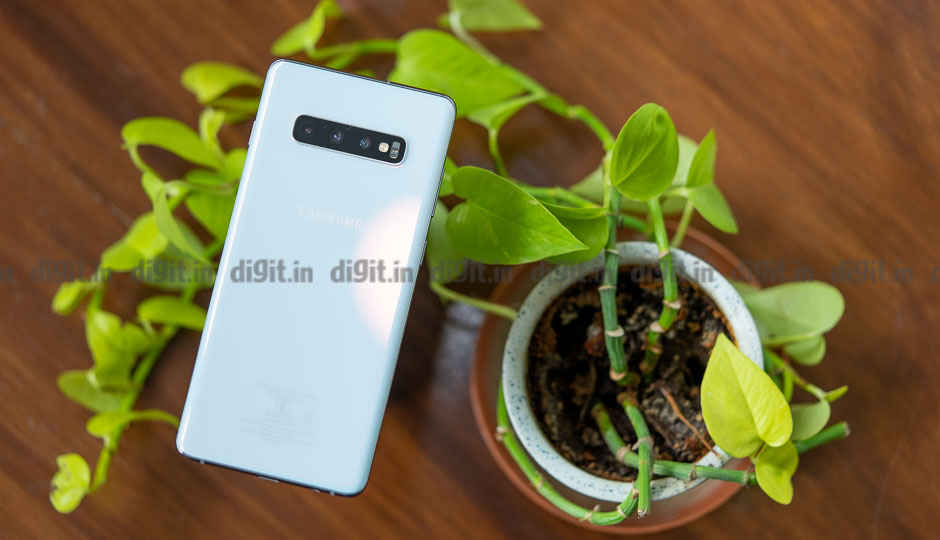 Highlights Snapdragon variant of Galaxy S10 beats Exynos variant on PCMark 2.0 Exynos 9820 20 percent faster than Exynos 9810 Samsung, for the last few years, has insisted on shipping its flagship smartphone with two different chipsets in individual markets. While countries like the U.S. get the Qualcomm Snapdragon-powered variant, India gets the Samsung Galaxy S10 powered by the company’s own Exynos 9820 processor. AnandTech has run early benchmarks on the Snapdragon and Exynos variants of the S10 and the results are rather interesting. The benchmarks run on the two phones include PCMark 2.0 and Speedometer 2.0. Traditionally, we have seen the Snapdragon-powered Galaxy S smartphones to be faster than their Exynos counterparts, and this report shows nothing different. For the most part, the Snapdragon 855 powered Samsung Galaxy S10 beats the Exynos variant by a large margin in most of PCMark’s testing parameters, including the Web Browsing, Photo Editing and even Writing 2.0 sub-tests. However, the findings reveal a more promising fact. Across all the tests, the Exynos 9820 performs significantly better than the Exynos 9810-powered S9 and Note 9. The last three generations of Samsung’s flagship Exynos chips had issues with the scheduler, which caused benchmark numbers on the chips to be lower than expected, but it appears that Samsung has fixed the problem with the new 9820 chipsets. AnandTech’s findings report a 20-percent improvement in performance on the new Exynos 9820 over the Exynos 9810, which is well within the reasonable realm of improvement. We have the Exynos variant of Samsung’s newest flagship, the Samsung Galaxy S10+ and will be putting the phone through our revamped testing process to determine just how much of a true performance bump it offers in comparison to the previous generation flagships from Samsung. Related Reads: Samsung Galaxy S10e First Impressions: Compact and uncompromising
Highlights Snapdragon variant of Galaxy S10 beats Exynos variant on PCMark 2.0 Exynos 9820 20 percent faster than Exynos 9810 Samsung, for the last few years, has insisted on shipping its flagship smartphone with two different chipsets in individual markets. While countries like the U.S. get the Qualcomm Snapdragon-powered variant, India gets the Samsung Galaxy S10 powered by the company’s own Exynos 9820 processor. AnandTech has run early benchmarks on the Snapdragon and Exynos variants of the S10 and the results are rather interesting. The benchmarks run on the two phones include PCMark 2.0 and Speedometer 2.0. Traditionally, we have seen the Snapdragon-powered Galaxy S smartphones to be faster than their Exynos counterparts, and this report shows nothing different. For the most part, the Snapdragon 855 powered Samsung Galaxy S10 beats the Exynos variant by a large margin in most of PCMark’s testing parameters, including the Web Browsing, Photo Editing and even Writing 2.0 sub-tests. However, the findings reveal a more promising fact. Across all the tests, the Exynos 9820 performs significantly better than the Exynos 9810-powered S9 and Note 9. The last three generations of Samsung’s flagship Exynos chips had issues with the scheduler, which caused benchmark numbers on the chips to be lower than expected, but it appears that Samsung has fixed the problem with the new 9820 chipsets. AnandTech’s findings report a 20-percent improvement in performance on the new Exynos 9820 over the Exynos 9810, which is well within the reasonable realm of improvement. We have the Exynos variant of Samsung’s newest flagship, the Samsung Galaxy S10+ and will be putting the phone through our revamped testing process to determine just how much of a true performance bump it offers in comparison to the previous generation flagships from Samsung. Related Reads: Samsung Galaxy S10e First Impressions: Compact and uncompromising Highlights: The next generation of Porsche Macan will be all electric, announces Porsche It will share the Porsche Taycan's 800-volt architecture Porsche predicts half of its models to be electric by 2025 The Macan is Porsche’s top-selling luxury crossover SUV. It’s been around in the market since 2014 and is now about to receive a major transformation. According to a news release sent out by Porsche, the next generation of the Porsche Macan will be fully electric. The big SUV joins the recently announced Taycan in this new electric revolution, on which Porsche will be investing six billion euros by the year 2022. According to Porsche, the decision to build the next-generation Macan at the company’s Leipzig plant was taken in early July last year. The German car maker believes the Macan “fires the starting pistol for electrification” of cars at Porsche. Like the Taycan, which—in turn—shares its architecture with the Audi e-tron GT, the Macan will use a newly developed 800-volt architecture. By 2025, Porsche expects fifty percent of all its vehicles to be electric. “Over the next ten years we will focus on a drive mix consisting of even further optimised petrol engines, plug-in hybrid models, and purely electrically operated sports cars. Our aim is to take a pioneering role in technology, and for this reason we will continue to consistently align the company with the mobility of the future,” commented Oliver Blume, Chairman of the Board of Management at Porsche AG. About two years ago, the German car maker expanded its production facility at Leipzig to double its production rate. The factory currently pushes out 90,000 units every year for global markets, as opposed to the 40,000 units it pushed out when the plant began operation in 2014. Recent news around the electric Porsche Taycan suggested that it would get a Turbo version at the time of its launch. It will be a 600-horsepower performance variant that’s expected to cost about Rs 90,95,000 in India. If Porsche follows the same variant separation strategy with the other electric cars in its stable, the Macan too could get a Turbo version. The name Turbo once referred to variants with turbocharged engines but has now evolved to refer to the top-end version in any Porsche model, electric vehicles included. Cover image courtesy: Porsche AG Related Read: All-electric Porsche Taycan to get a 'Turbo' variant, will start from $130,000
Highlights: The next generation of Porsche Macan will be all electric, announces Porsche It will share the Porsche Taycan's 800-volt architecture Porsche predicts half of its models to be electric by 2025 The Macan is Porsche’s top-selling luxury crossover SUV. It’s been around in the market since 2014 and is now about to receive a major transformation. According to a news release sent out by Porsche, the next generation of the Porsche Macan will be fully electric. The big SUV joins the recently announced Taycan in this new electric revolution, on which Porsche will be investing six billion euros by the year 2022. According to Porsche, the decision to build the next-generation Macan at the company’s Leipzig plant was taken in early July last year. The German car maker believes the Macan “fires the starting pistol for electrification” of cars at Porsche. Like the Taycan, which—in turn—shares its architecture with the Audi e-tron GT, the Macan will use a newly developed 800-volt architecture. By 2025, Porsche expects fifty percent of all its vehicles to be electric. “Over the next ten years we will focus on a drive mix consisting of even further optimised petrol engines, plug-in hybrid models, and purely electrically operated sports cars. Our aim is to take a pioneering role in technology, and for this reason we will continue to consistently align the company with the mobility of the future,” commented Oliver Blume, Chairman of the Board of Management at Porsche AG. About two years ago, the German car maker expanded its production facility at Leipzig to double its production rate. The factory currently pushes out 90,000 units every year for global markets, as opposed to the 40,000 units it pushed out when the plant began operation in 2014. Recent news around the electric Porsche Taycan suggested that it would get a Turbo version at the time of its launch. It will be a 600-horsepower performance variant that’s expected to cost about Rs 90,95,000 in India. If Porsche follows the same variant separation strategy with the other electric cars in its stable, the Macan too could get a Turbo version. The name Turbo once referred to variants with turbocharged engines but has now evolved to refer to the top-end version in any Porsche model, electric vehicles included. Cover image courtesy: Porsche AG Related Read: All-electric Porsche Taycan to get a 'Turbo' variant, will start from $130,000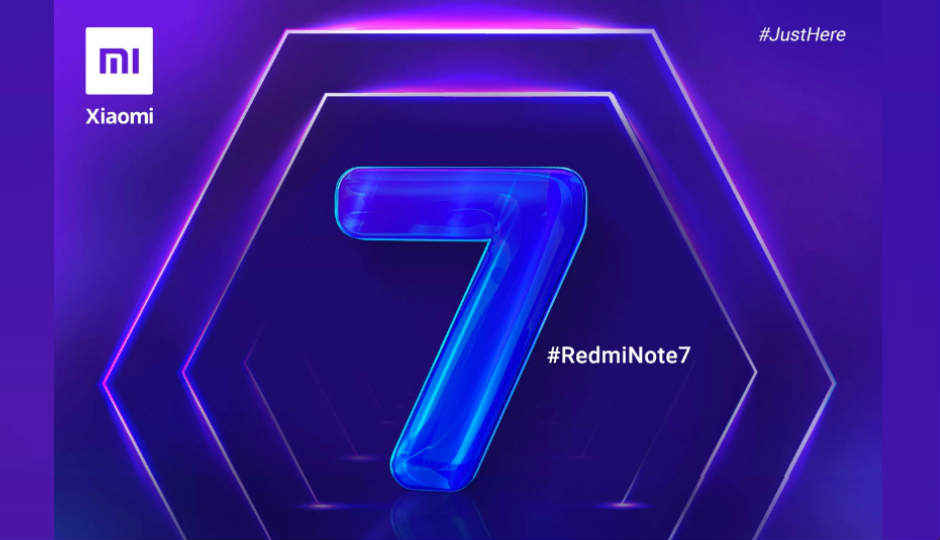 The Xiaomi Redmi Note 7 will be launched in India on Thursday. The company is hosting an event in New Delhi to unveil the mid-ranger that is already available in China. Like with every Redmi Note device, Xiaomi plans to cut ahead of the competition this time as well. The Redmi Note 7 offers a 48-megapixel camera on the back, which Xiaomi hopes will set the phone apart from the rest. The company is also expected to announce the Redmi Note 7 Pro and the Redmi Go at the event. Over the course of the past few months, multiple leaks and rumours have given us an idea how the Redmi Note 7 Pro will turn out to be. Before the phone launches in India, here’s everything you need to know — How to watch the Xiaomi Redmi Note 7 launch live? The Redmi Note 7 launch is expected to start at 11:30AM. The event will be streamed live on Xiaomi’s social pages on YouTube, Twitter and Facebook. Digit will also go live from the event, so you can tune into our Instagram page to get all the action. What does the Redmi Note 7 offer? The Redmi Note 7 went official in China a month ago. The phone offers a 48MP Samsung GM-1 sensor on the back coupled with a 5MP depth sensor for portrait photos. On the front, there’s a 13MP selfie camera, housed in a waterdrop notch. There’s a 6.3-inch LCD display with Gorilla Glass 5 on top. The phone is powered by a Qualcomm Snapdragon 660 SoC and is offered in three RAM/storage variants. Xiaomi is expected to launch the phone in 3/32GB, 4/64GB and 6/64GB variants. Xiaomi also claimed the phone to have exceptional durability thanks to the protective glass on both sides. The phone also packs a 4,000mAh battery and now finally supports fast charging. The Redmi Note 7 is expected to come in a range of gradient colour finishes including red, blue and black and twilight gold. Will Xiaomi launch the Redmi Note 7 Pro? At the China launch of the Redmi Note 7, Xiaomi did tease the launch of the pro variant. After that, Lu Weibing, Redmi General Manager, shared the Redmi Note 7 Pro will be announced after the Xiaomi Mi 9. The Mi 9 launched on February 20 and the timeline adds up. Furthermore, we have seen multiple leaks of the phone detailing the specs and features. Based on the latest leak by smartphone leakster @ishanagarwal24, the Redmi Note 7 Pro is expected to bring the flagship Sony IMX586 sensor with 48MP resolution and a 1/2-inch sensor size. If the recently launched Honor View 20 is anything to go by, the camera offers a good amount of detail and has features like pixel-binning to improve low-light photography. The form factor is expected to remain the same as the Redmi Note 7 — A 6.3-inch display with a waterdrop notch. However, under the hood, the phone is expected to pack the Snapdragon 675 SoC, which we saw debut in the Vivo V15 Pro. Based on our performance comparison, the chipset is much more powerful than the Snapdragon 660, sometimes even beating the Snapdragon 710. What about the Xiaomi Redmi Go? The Xiaomi Redmi Go is an Android-Go device made for the entry-level segment. It’s Xiaomi’s first smartphone with Android Go and is expected to run a toned-down version of MIUI. The phone went official with a 5-inch HD display and a Snapdragon 425 SoC under the hood. The phone is based on Android Oreo (Go Edition) and offers 1GB RAM and 8GB of expandable storage. On the back is an 8MP camera while the front houses a 5MP selfie shooter. The phone packs a 2,200mAh battery. Redmi Note 7, Redmi Note 7 Pro, Redmi Go Price The Xiaomi Redmi Note 7 was launched for an astoundingly low price of RMB 999 in China which roughly converts to Rs 10,000 in India. While the phone certainly won’t be priced that cheap, considering import duties that Xiaomi has to pay for the components, we expect the phone to be priced under Rs 15,000. The Redmi Note 7 Pro with the 48MP Sony sensor is expected to fetch a higher price. We expect the price to be around Rs 16,000. The entry-level Redmi Go is expected to be priced below the going market price of other Android Go phones like the Samsung Galaxy J2 Core and the Nokia 1. WinFuture reports the phone will be priced under 80 Euros in Europe, which rough converts to Rs 6,400 in India.
The Xiaomi Redmi Note 7 will be launched in India on Thursday. The company is hosting an event in New Delhi to unveil the mid-ranger that is already available in China. Like with every Redmi Note device, Xiaomi plans to cut ahead of the competition this time as well. The Redmi Note 7 offers a 48-megapixel camera on the back, which Xiaomi hopes will set the phone apart from the rest. The company is also expected to announce the Redmi Note 7 Pro and the Redmi Go at the event. Over the course of the past few months, multiple leaks and rumours have given us an idea how the Redmi Note 7 Pro will turn out to be. Before the phone launches in India, here’s everything you need to know — How to watch the Xiaomi Redmi Note 7 launch live? The Redmi Note 7 launch is expected to start at 11:30AM. The event will be streamed live on Xiaomi’s social pages on YouTube, Twitter and Facebook. Digit will also go live from the event, so you can tune into our Instagram page to get all the action. What does the Redmi Note 7 offer? The Redmi Note 7 went official in China a month ago. The phone offers a 48MP Samsung GM-1 sensor on the back coupled with a 5MP depth sensor for portrait photos. On the front, there’s a 13MP selfie camera, housed in a waterdrop notch. There’s a 6.3-inch LCD display with Gorilla Glass 5 on top. The phone is powered by a Qualcomm Snapdragon 660 SoC and is offered in three RAM/storage variants. Xiaomi is expected to launch the phone in 3/32GB, 4/64GB and 6/64GB variants. Xiaomi also claimed the phone to have exceptional durability thanks to the protective glass on both sides. The phone also packs a 4,000mAh battery and now finally supports fast charging. The Redmi Note 7 is expected to come in a range of gradient colour finishes including red, blue and black and twilight gold. Will Xiaomi launch the Redmi Note 7 Pro? At the China launch of the Redmi Note 7, Xiaomi did tease the launch of the pro variant. After that, Lu Weibing, Redmi General Manager, shared the Redmi Note 7 Pro will be announced after the Xiaomi Mi 9. The Mi 9 launched on February 20 and the timeline adds up. Furthermore, we have seen multiple leaks of the phone detailing the specs and features. Based on the latest leak by smartphone leakster @ishanagarwal24, the Redmi Note 7 Pro is expected to bring the flagship Sony IMX586 sensor with 48MP resolution and a 1/2-inch sensor size. If the recently launched Honor View 20 is anything to go by, the camera offers a good amount of detail and has features like pixel-binning to improve low-light photography. The form factor is expected to remain the same as the Redmi Note 7 — A 6.3-inch display with a waterdrop notch. However, under the hood, the phone is expected to pack the Snapdragon 675 SoC, which we saw debut in the Vivo V15 Pro. Based on our performance comparison, the chipset is much more powerful than the Snapdragon 660, sometimes even beating the Snapdragon 710. What about the Xiaomi Redmi Go? The Xiaomi Redmi Go is an Android-Go device made for the entry-level segment. It’s Xiaomi’s first smartphone with Android Go and is expected to run a toned-down version of MIUI. The phone went official with a 5-inch HD display and a Snapdragon 425 SoC under the hood. The phone is based on Android Oreo (Go Edition) and offers 1GB RAM and 8GB of expandable storage. On the back is an 8MP camera while the front houses a 5MP selfie shooter. The phone packs a 2,200mAh battery. Redmi Note 7, Redmi Note 7 Pro, Redmi Go Price The Xiaomi Redmi Note 7 was launched for an astoundingly low price of RMB 999 in China which roughly converts to Rs 10,000 in India. While the phone certainly won’t be priced that cheap, considering import duties that Xiaomi has to pay for the components, we expect the phone to be priced under Rs 15,000. The Redmi Note 7 Pro with the 48MP Sony sensor is expected to fetch a higher price. We expect the price to be around Rs 16,000. The entry-level Redmi Go is expected to be priced below the going market price of other Android Go phones like the Samsung Galaxy J2 Core and the Nokia 1. WinFuture reports the phone will be priced under 80 Euros in Europe, which rough converts to Rs 6,400 in India.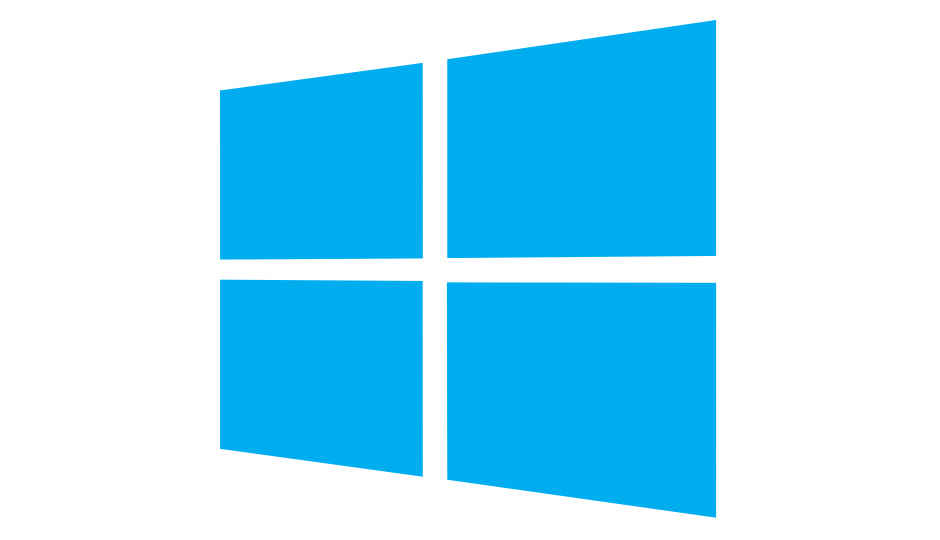 Highlights: Microsoft's new Lite OS could take on Chrome OS It will share its core with Windows 10 Rumours of a Microsoft equivalent to the well-established Chrome OS have been making rounds on the internet for a few weeks now. It has been referred to in the past as “Windows Lite” but it appears we have an accurate name now. Brand Sams of Petri believes Microsoft’s new operating system will be called Lite OS and is currently codenamed “Santorini”. Microsoft is reportedly working very hard to bring the software out as soon as possible. When it releases, Lite OS will target Chromebooks, which are mostly entry-level laptops that run Chrome OS. Though Lite OS is expected to be launched as a standalone operating system for PCs with basic specifications, it’s believed to share its core with Windows. The Petri writer went so far as to develop a mockup of Lite OS’ user interface. “The mockup I created at the top of this post is an accurate portrayal of what the OS looks like in its current iteration. Despite the updated UI, the OOBE (Out of Box Experience) is still similar to that of Windows 10,” writes Sams. While it may appear as if Microsoft is splitting its Windows 10 operating system into two streams (one for light users and another for heavy users), Sams is convinced that that’s not the case. Lite OS will eventually cover most of the functionality found in Windows 10 today. Lite OS is predicted to run only Universal Windows Platform (UWP) apps and Progressive Web Apps (PWAs) at the moment but may include support for traditional Win32 applications in the future. This isn’t Microsoft’s first attempt at creating a Windows spin-off that’s designed to run on entry-level PCs. Windows RT was born out of Windows 8.1 in 2012 in an attempt to cater to “thin and light PCs that have extended battery life and are designed for life on the go”. Windows RT was received rather badly during its time but there is a chance Lite OS will win where Windows RT failed. For beginners, both the quality and quantity of UWP apps on the Microsoft Store have increased. Also, Microsoft is working hard to make many traditional Win32 applications UWP apps. With any luck, laptops under the Rs 25,000 mark could ship with Lite OS in the near future instead of DOS or Linux. Inline image courtesy: Petri Related Read: Windows 7 support to end in a year, Microsoft says
Highlights: Microsoft's new Lite OS could take on Chrome OS It will share its core with Windows 10 Rumours of a Microsoft equivalent to the well-established Chrome OS have been making rounds on the internet for a few weeks now. It has been referred to in the past as “Windows Lite” but it appears we have an accurate name now. Brand Sams of Petri believes Microsoft’s new operating system will be called Lite OS and is currently codenamed “Santorini”. Microsoft is reportedly working very hard to bring the software out as soon as possible. When it releases, Lite OS will target Chromebooks, which are mostly entry-level laptops that run Chrome OS. Though Lite OS is expected to be launched as a standalone operating system for PCs with basic specifications, it’s believed to share its core with Windows. The Petri writer went so far as to develop a mockup of Lite OS’ user interface. “The mockup I created at the top of this post is an accurate portrayal of what the OS looks like in its current iteration. Despite the updated UI, the OOBE (Out of Box Experience) is still similar to that of Windows 10,” writes Sams. While it may appear as if Microsoft is splitting its Windows 10 operating system into two streams (one for light users and another for heavy users), Sams is convinced that that’s not the case. Lite OS will eventually cover most of the functionality found in Windows 10 today. Lite OS is predicted to run only Universal Windows Platform (UWP) apps and Progressive Web Apps (PWAs) at the moment but may include support for traditional Win32 applications in the future. This isn’t Microsoft’s first attempt at creating a Windows spin-off that’s designed to run on entry-level PCs. Windows RT was born out of Windows 8.1 in 2012 in an attempt to cater to “thin and light PCs that have extended battery life and are designed for life on the go”. Windows RT was received rather badly during its time but there is a chance Lite OS will win where Windows RT failed. For beginners, both the quality and quantity of UWP apps on the Microsoft Store have increased. Also, Microsoft is working hard to make many traditional Win32 applications UWP apps. With any luck, laptops under the Rs 25,000 mark could ship with Lite OS in the near future instead of DOS or Linux. Inline image courtesy: Petri Related Read: Windows 7 support to end in a year, Microsoft says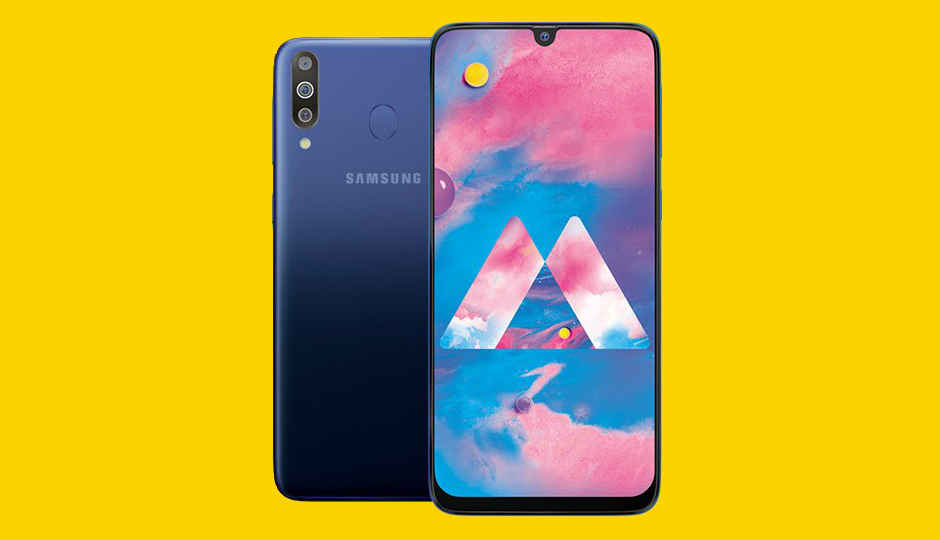 Highlights: Samsung Galaxy M30 launched in India. The smartphone features the new Exynos 7904 processor. It comes equipped with a triple rear camera setup. After teasing and revealing some aspects of the Samsung Galaxy M30, the company has launched the phone in India. It is the third device in Samsung’s M series of handsets and it brings a triple-rear camera to the sub 20k price segment. The Galaxy M30 is expected to go up against the Xiaomi Redmi Note 7 smartphone, which will launch tomorrow in India and is priced in the same range as the Redmi Note 7 is rumoured to be placed in. Highlights of the phone include a large 5000mAh battery and the new Exynos 7904 octa-core processor that it is powered by. Samsung Galaxy M30 Specifications The Samsung Galaxy M30 is powered by the Exynos 7904 octa-core processor that is clocked at 1.8Ghz. It is the newest SoC by the company, which is debuting in a device. The phone comes in two variants. One with 4GB RAM, coupled with 64GB of internal storage and another with 6GB RAM with 128GB of onboard storage. The handset features a 6.4-inch Full HD+ Super AMOLED Infinity U display and will be available in Gradation Black and Gradation Blue colour models. The device sports a dedicated slot for microSD card and supports memory expansion till 512GB. It is backed by a large 5000mAh battery. Coming to the optics, the Galaxy M30 sports a 13MP + 5MP + 5MP triple rear-camera setup. Here, the 13MP sensor is the main camera with an f/1.9 aperture lens, while the 5MP sensor assists in capturing bokeh images. The other 5MP sensor is paired with an f/2.4 lens that enables shooting ultra-wide images. On the front, the device comes equipped with a 16MP sensor that is coupled with an f/2.0 aperture lens. It runs on Samsung Experience 9.5 and comes with Widevine L1 certification. It sports a fingerprint sensor on the rear and also comes with face unlock. Samsung Galaxy M30 Pricing and Availability The Samsung Galaxy M30 is priced at Rs 14,990 for the 4GB RAM, 64GB storage variant and is priced at Rs 17,990 for the 6GB RAM, 128GB version. It will go on sale via Samsung Shop and Amazon at 12 PM on March 7 in Gradation Black and Gradation Blue colour models.
Highlights: Samsung Galaxy M30 launched in India. The smartphone features the new Exynos 7904 processor. It comes equipped with a triple rear camera setup. After teasing and revealing some aspects of the Samsung Galaxy M30, the company has launched the phone in India. It is the third device in Samsung’s M series of handsets and it brings a triple-rear camera to the sub 20k price segment. The Galaxy M30 is expected to go up against the Xiaomi Redmi Note 7 smartphone, which will launch tomorrow in India and is priced in the same range as the Redmi Note 7 is rumoured to be placed in. Highlights of the phone include a large 5000mAh battery and the new Exynos 7904 octa-core processor that it is powered by. Samsung Galaxy M30 Specifications The Samsung Galaxy M30 is powered by the Exynos 7904 octa-core processor that is clocked at 1.8Ghz. It is the newest SoC by the company, which is debuting in a device. The phone comes in two variants. One with 4GB RAM, coupled with 64GB of internal storage and another with 6GB RAM with 128GB of onboard storage. The handset features a 6.4-inch Full HD+ Super AMOLED Infinity U display and will be available in Gradation Black and Gradation Blue colour models. The device sports a dedicated slot for microSD card and supports memory expansion till 512GB. It is backed by a large 5000mAh battery. Coming to the optics, the Galaxy M30 sports a 13MP + 5MP + 5MP triple rear-camera setup. Here, the 13MP sensor is the main camera with an f/1.9 aperture lens, while the 5MP sensor assists in capturing bokeh images. The other 5MP sensor is paired with an f/2.4 lens that enables shooting ultra-wide images. On the front, the device comes equipped with a 16MP sensor that is coupled with an f/2.0 aperture lens. It runs on Samsung Experience 9.5 and comes with Widevine L1 certification. It sports a fingerprint sensor on the rear and also comes with face unlock. Samsung Galaxy M30 Pricing and Availability The Samsung Galaxy M30 is priced at Rs 14,990 for the 4GB RAM, 64GB storage variant and is priced at Rs 17,990 for the 6GB RAM, 128GB version. It will go on sale via Samsung Shop and Amazon at 12 PM on March 7 in Gradation Black and Gradation Blue colour models.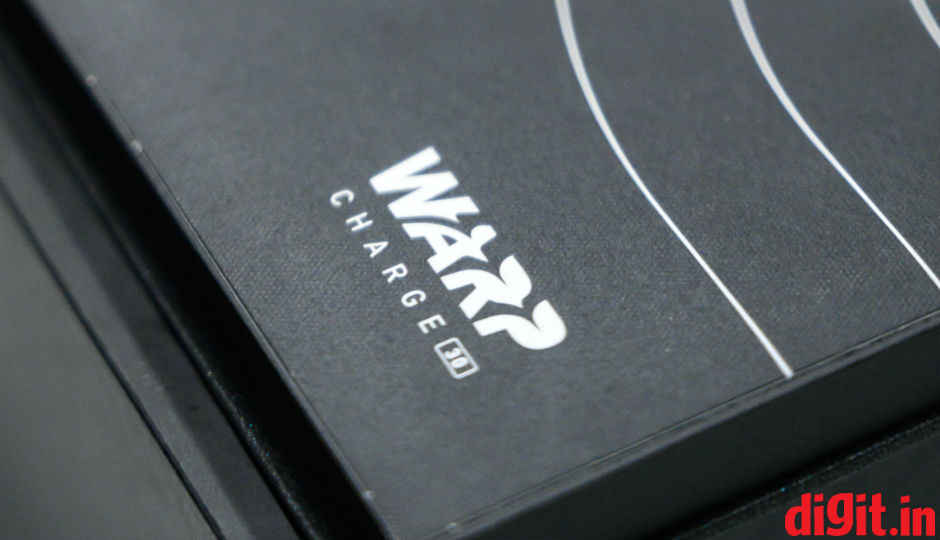 Highlights: Wireless charging won't debut on the upcoming OnePlus flagship, Pete Lau confirms. OnePlus believes the tech is not fast enough to match the 'Warp Charge' speeds. The next OnePlus phone is expected to be powered by the Snapdragon 855. OnePlus still believes wireless charging is at a nascent stage, and as such, the technology won’t feature in the upcoming OnePlus flagship, Pete Lau confirmed to CNET. Instead, the upcoming flagship, probably named the OnePlus 7, will come with Warp Charge, which Lau believes is “one of the best” in the industry. Until wireless charging is capable of delivering similar charging speeds without heating up, OnePlus won’t consider introducing the tech in its phones. However, Qualcomm did give a boost to the wireless charging standards by debuting Quick Charge for wireless charging at MWC 2019. Lau also stated OnePlus is working on making wireless charging faster without heating up, but didn’t reveal a specific timeline as to when we can see that in action on a OnePlus device. It’s also unlikely that OnePlus will adopt Qualcomm’s Quick Charge standards, given its Warp Charge speeds are much higher in comparison. The company did confirm the next OnePlus device will launch with the flagship Qualcomm Snapdragon 855 under the hood. The rest of the specs remain unknown, but it’s expected the phone will come with an Android 9-Pie based OxygenOS UI. A recently leaked photo even suggested the phone could be all-screen on the front, with a pop-up selfie camera. OnePlus also showcased its 5G prototype at the Qualcomm booth at MWC 2019. It’s covered in a case and one can only see the device’s screen. It’s confirmed to be powered by the Snapdragon 855 SoC and uses the Snapdragon X50 modem for 5G connectivity. The 5G flagship is expected to launch in May 2019 and could be priced $200-$300 higher than the previous OnePlus flagship. Related Reads: OnePlus 7 alleged live image leak shows off a notchless display OnePlus 5G prototype showcased at MWC 2019 OnePlus partners with Qualcomm to begin 5G trials in India, announces "5G Apps of Tomorrow" challenge
Highlights: Wireless charging won't debut on the upcoming OnePlus flagship, Pete Lau confirms. OnePlus believes the tech is not fast enough to match the 'Warp Charge' speeds. The next OnePlus phone is expected to be powered by the Snapdragon 855. OnePlus still believes wireless charging is at a nascent stage, and as such, the technology won’t feature in the upcoming OnePlus flagship, Pete Lau confirmed to CNET. Instead, the upcoming flagship, probably named the OnePlus 7, will come with Warp Charge, which Lau believes is “one of the best” in the industry. Until wireless charging is capable of delivering similar charging speeds without heating up, OnePlus won’t consider introducing the tech in its phones. However, Qualcomm did give a boost to the wireless charging standards by debuting Quick Charge for wireless charging at MWC 2019. Lau also stated OnePlus is working on making wireless charging faster without heating up, but didn’t reveal a specific timeline as to when we can see that in action on a OnePlus device. It’s also unlikely that OnePlus will adopt Qualcomm’s Quick Charge standards, given its Warp Charge speeds are much higher in comparison. The company did confirm the next OnePlus device will launch with the flagship Qualcomm Snapdragon 855 under the hood. The rest of the specs remain unknown, but it’s expected the phone will come with an Android 9-Pie based OxygenOS UI. A recently leaked photo even suggested the phone could be all-screen on the front, with a pop-up selfie camera. OnePlus also showcased its 5G prototype at the Qualcomm booth at MWC 2019. It’s covered in a case and one can only see the device’s screen. It’s confirmed to be powered by the Snapdragon 855 SoC and uses the Snapdragon X50 modem for 5G connectivity. The 5G flagship is expected to launch in May 2019 and could be priced $200-$300 higher than the previous OnePlus flagship. Related Reads: OnePlus 7 alleged live image leak shows off a notchless display OnePlus 5G prototype showcased at MWC 2019 OnePlus partners with Qualcomm to begin 5G trials in India, announces "5G Apps of Tomorrow" challenge Highlights: Spotify officially launched in India. It offers free and premium subscription plans to users. Here’s how the two tiers compare. Spotify has finally officially launched its services in India and it comes in both, free and premium, plans. The service can now be used in the country as a web app, desktop app, on iOS and Android devices without needing a VPN. The company has also priced it competitively as it starts at almost the same price as Apple Music, at Rs 119 per month, for users who have never opted for Spotify Premium previously, but what extra do you get when going for the premium account subscription over the free one? Which one would suit you better? These are some of the questions one will find answers to in this article, along with some more information on the newly launched online music streaming service. Spotify Free VS Spotify Premium Same as many other music streaming services in India, Spotify also enables users to create a free account to stream music from. There is no charge levied on free account holders, however, one will encounter ads between songs. Ads are a basic way for any music streaming service to generate revenue and free Spotify users in other countries also encounter ads every four or five songs when listening to music. Additionally, they can only skip six songs in the span of an hour and Spotify employs shuffle play that disables users to select what they want to listen to and if one wants to listen to a particular track, they can add it to the queue and hope it comes on. Fortunately, Spotify has not implemented track skip limit or Shuffle Play in India, which means users here can skip and play the songs, all they want. However, upgrading to a premium Spotify account means there won’t be any annoying ads between songs. Additionally, there are some perks only a premium user gets to enjoy like the ability to download and listen to music offline and bumping up the audio playback quality to 320kbps. These features will help users to save up on data since the internet connectivity in India is still patchy in many areas. So, does it make sense to upgrade to Spotify premium? Well, it depends. If you are someone who can’t bear ad interruptions while listening to music, or want to save data by downloading songs when streaming offline, then it makes complete sense to go for the Premium subscription. Additionally, keep in mind that Spotify is well known for using algorithms to curate playlists for users based on their mood. This is the key highlight of Spotify and we ourselves are impressed by how quickly the app learns from a user’s listening habits and plays favourable tracks accordingly. Spotify is offering a 30-day free Premium tier trial so that one can try it before shelling out Rs 119 per month for the service. Interestingly, the app’s premium service can also be availed for one day or a week, along with the regular one month, six months and one-year prepaid plans. For students, Spotify premium is available with a great discount as it starts at Rs 59 per month, just Rs 1 shy of what Apple Music offers for students. Related Reads: Spotify officially launched in India, Premium plans start at Rs 119 per month
Highlights: Spotify officially launched in India. It offers free and premium subscription plans to users. Here’s how the two tiers compare. Spotify has finally officially launched its services in India and it comes in both, free and premium, plans. The service can now be used in the country as a web app, desktop app, on iOS and Android devices without needing a VPN. The company has also priced it competitively as it starts at almost the same price as Apple Music, at Rs 119 per month, for users who have never opted for Spotify Premium previously, but what extra do you get when going for the premium account subscription over the free one? Which one would suit you better? These are some of the questions one will find answers to in this article, along with some more information on the newly launched online music streaming service. Spotify Free VS Spotify Premium Same as many other music streaming services in India, Spotify also enables users to create a free account to stream music from. There is no charge levied on free account holders, however, one will encounter ads between songs. Ads are a basic way for any music streaming service to generate revenue and free Spotify users in other countries also encounter ads every four or five songs when listening to music. Additionally, they can only skip six songs in the span of an hour and Spotify employs shuffle play that disables users to select what they want to listen to and if one wants to listen to a particular track, they can add it to the queue and hope it comes on. Fortunately, Spotify has not implemented track skip limit or Shuffle Play in India, which means users here can skip and play the songs, all they want. However, upgrading to a premium Spotify account means there won’t be any annoying ads between songs. Additionally, there are some perks only a premium user gets to enjoy like the ability to download and listen to music offline and bumping up the audio playback quality to 320kbps. These features will help users to save up on data since the internet connectivity in India is still patchy in many areas. So, does it make sense to upgrade to Spotify premium? Well, it depends. If you are someone who can’t bear ad interruptions while listening to music, or want to save data by downloading songs when streaming offline, then it makes complete sense to go for the Premium subscription. Additionally, keep in mind that Spotify is well known for using algorithms to curate playlists for users based on their mood. This is the key highlight of Spotify and we ourselves are impressed by how quickly the app learns from a user’s listening habits and plays favourable tracks accordingly. Spotify is offering a 30-day free Premium tier trial so that one can try it before shelling out Rs 119 per month for the service. Interestingly, the app’s premium service can also be availed for one day or a week, along with the regular one month, six months and one-year prepaid plans. For students, Spotify premium is available with a great discount as it starts at Rs 59 per month, just Rs 1 shy of what Apple Music offers for students. Related Reads: Spotify officially launched in India, Premium plans start at Rs 119 per month 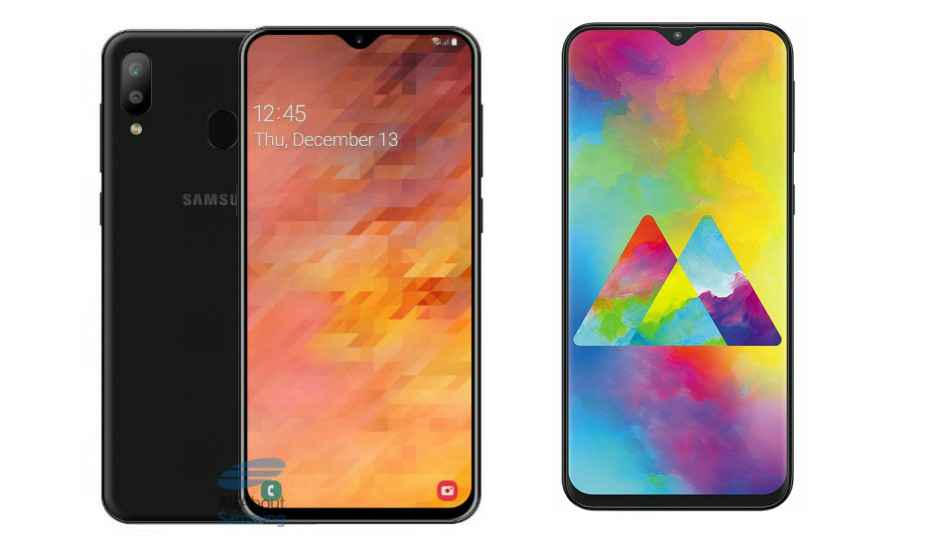 Samsung is all set to unveil its M30 in India today at 6 PM. As per the company, the phone will come with a 6.4-inch Super AMOLED display and a triple camera setup on the back that will also have an ultra-wide angle lens. The phone packs 5,000mAh battery that supports 15W fast charging. We are comparing the device with the Samsung newly launched Galaxy M20, which comes with a dual camera setup on the back and a display with a water drop notch. So, let’s compare these two phones on the basis of Samsung’s M30 expected price and specifications. Display The Samsung Galaxy M30 is tipped to feature a 6.4-inch FHD+ AMOLED Infinity-U display. On the other hand, the Galaxy M20 sports a 6.3-inch display that offers a resolution of 1080 x 2340 pixels. Processor, RAM, and storage Both the smartphones are powered by an Exynos 7904 octa-core processor, which are paired with 4GB RAM and 64GB internal memory that is expandable to up to 512GB via a microSD card. Cameras The Samsung Galaxy M30 is expected to come with a triple camera setup on the back. It is tipped to feature a telephoto lens, a wide angle lens, and an ultra-wide angle sensor as well. On the front, the phone is rumored to come with a 16MP sensor. On the other side, the Galaxy M20 has a dual 13MP + 5MP camera setup on the back along with an 8MP unit on the front for clicking selfies. Price The Samsung Galaxy M20 is available in India at a price of Rs 12,990, while The Samsung Galaxy M30 will launch today in India at 6 PM.
Samsung is all set to unveil its M30 in India today at 6 PM. As per the company, the phone will come with a 6.4-inch Super AMOLED display and a triple camera setup on the back that will also have an ultra-wide angle lens. The phone packs 5,000mAh battery that supports 15W fast charging. We are comparing the device with the Samsung newly launched Galaxy M20, which comes with a dual camera setup on the back and a display with a water drop notch. So, let’s compare these two phones on the basis of Samsung’s M30 expected price and specifications. Display The Samsung Galaxy M30 is tipped to feature a 6.4-inch FHD+ AMOLED Infinity-U display. On the other hand, the Galaxy M20 sports a 6.3-inch display that offers a resolution of 1080 x 2340 pixels. Processor, RAM, and storage Both the smartphones are powered by an Exynos 7904 octa-core processor, which are paired with 4GB RAM and 64GB internal memory that is expandable to up to 512GB via a microSD card. Cameras The Samsung Galaxy M30 is expected to come with a triple camera setup on the back. It is tipped to feature a telephoto lens, a wide angle lens, and an ultra-wide angle sensor as well. On the front, the phone is rumored to come with a 16MP sensor. On the other side, the Galaxy M20 has a dual 13MP + 5MP camera setup on the back along with an 8MP unit on the front for clicking selfies. Price The Samsung Galaxy M20 is available in India at a price of Rs 12,990, while The Samsung Galaxy M30 will launch today in India at 6 PM. 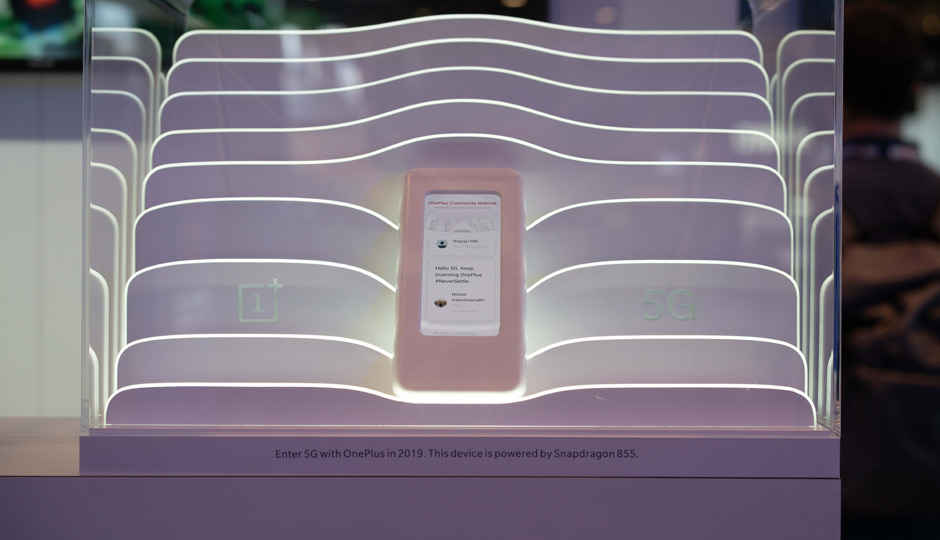 Highlights: OnePlus to start 5G trials in India with Qualcomm. The company will also be one of the first to bring a device powered by the Snapdragon 855 to India. OnePlus also announced the "5G apps of Tomorrow" challenge. Even without releasing a new device, OnePlus has a big presence at this year’s MWC in Barcelona. The company is showcasing it’s 5G prototype device at the Qualcomm booth in the tradeshow where a company executive is demonstrating how cloud gaming will look on 5G. However, the 5G device that OnePlus has announced it will launch this year will be restricted to a select few markets for now where 5G is commercially available. In another announcement, OnePlus said the company has teamed up with Qualcomm to start 5G trials in India. 5G is still a distant dream in India as the spectrum allocation for the next-generation wireless networks is still due to happen. Even OnePlus didn’t delve deep into what the partnership means as of now. OnePlus reportedly began researching on 5G in 2016 and a year later in 2017, the company partnered with Qualcomm to develop a 5G-enabled device. Later in 2018, the company managed to set up a successful 5G connection to Qualcomm’s labs in San Diego. The company also announced it would be one of the first OEMs to bring the Qualcomm Snapdragon 855 chipset to India. Apart from this, OnePlus announced its “5G Apps of Tomorrow” challenge for Android developers, in partnership with Qualcomm. The winners of the challenge will receive 20,000 euros in cash along with other supporting resources. You can participate in the challenge by heading to OnePlus.com/5G. The microsite is open from today and closes on March 26. The winners will be decided by a panel of executives including the CEOs of OnePlus and EE, along with a community vote. Furthermore, the top 5 ideas of a 5G-enabled app will receive a paid-for trip to the OnePlus HQ in Shenzhen to sit down with Pete Lau to discuss their ideas, a OnePlus 5G device, access to 5G experts on the OnePlus forums, access to EE’s test environment and financial support for a year. Related Reads: OnePlus 5G prototype showcased at MWC 2019 OnePlus prototype device successfully sent out a tweet on a 5G network
Highlights: OnePlus to start 5G trials in India with Qualcomm. The company will also be one of the first to bring a device powered by the Snapdragon 855 to India. OnePlus also announced the "5G apps of Tomorrow" challenge. Even without releasing a new device, OnePlus has a big presence at this year’s MWC in Barcelona. The company is showcasing it’s 5G prototype device at the Qualcomm booth in the tradeshow where a company executive is demonstrating how cloud gaming will look on 5G. However, the 5G device that OnePlus has announced it will launch this year will be restricted to a select few markets for now where 5G is commercially available. In another announcement, OnePlus said the company has teamed up with Qualcomm to start 5G trials in India. 5G is still a distant dream in India as the spectrum allocation for the next-generation wireless networks is still due to happen. Even OnePlus didn’t delve deep into what the partnership means as of now. OnePlus reportedly began researching on 5G in 2016 and a year later in 2017, the company partnered with Qualcomm to develop a 5G-enabled device. Later in 2018, the company managed to set up a successful 5G connection to Qualcomm’s labs in San Diego. The company also announced it would be one of the first OEMs to bring the Qualcomm Snapdragon 855 chipset to India. Apart from this, OnePlus announced its “5G Apps of Tomorrow” challenge for Android developers, in partnership with Qualcomm. The winners of the challenge will receive 20,000 euros in cash along with other supporting resources. You can participate in the challenge by heading to OnePlus.com/5G. The microsite is open from today and closes on March 26. The winners will be decided by a panel of executives including the CEOs of OnePlus and EE, along with a community vote. Furthermore, the top 5 ideas of a 5G-enabled app will receive a paid-for trip to the OnePlus HQ in Shenzhen to sit down with Pete Lau to discuss their ideas, a OnePlus 5G device, access to 5G experts on the OnePlus forums, access to EE’s test environment and financial support for a year. Related Reads: OnePlus 5G prototype showcased at MWC 2019 OnePlus prototype device successfully sent out a tweet on a 5G network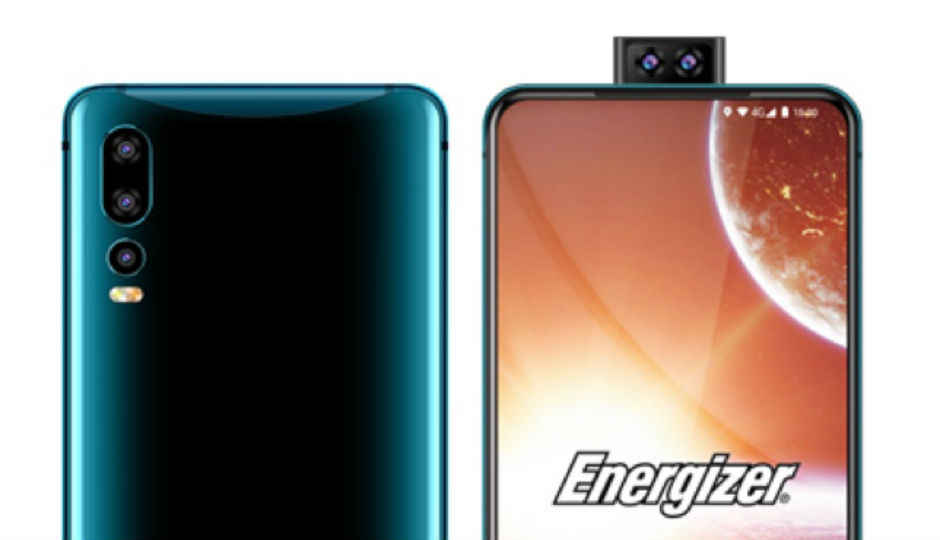 Highlights: Energiser Power Max P18K Pop has been announced at MWC 2019 The smartphone has a whopping 18,000mAh battery The device has a triple camera setup at the back and a dual front popup camera If battery life is of utmost importance to you then you can consider the Energiser Power Max P18K Pop. The 18K in the name doesn’t stand for 18k gold, rather the massive 18,000mAh battery that is powering the device. Yes, the smartphone has an 18,000mAh battery and as you can imagine, this makes the phone extremely thick. To put things into perspective, the smartphone is 3 to 3.5 iPhones thick. The battery on the Energiser Power Max P18K Pop is said to last for 200 hours of video playback, or 50 days of standby time. Energizer also says that the device supports fast charging. This is great but remember that the phone will take 8 to 9 hours to reach full charge. Speaking of the specifications of the smartphone, it is powered by the Helio P70 chipset coupled with 6GB of RAM. At the back, the smartphone has a triple camera setup, which consists of a 12MP+5MP+2MP setup. The front has a dual selfie camera which is a 16+2MP popup camera. When it comes to storage, the device has 128GB built-in storage. It also sports a fingerprint sensor. The P18K is a dual-SIM smartphone. It has a 6.2-inch, Full HD+ display with an aspect ratio of 18:9 and is running on Android 9 Pie out of the box. According to Android Authority “The Power Max P18K Pop price will be set at 599 euros (Rs 49,000 approx. directly converted) when it’s launched in Europe this June”. There is no information on whether the device will make its way to india. Having a smartphone with a 4,000, 5,000 or even a 5,300mAh battery is quite common. We have seen a few exceptions bringing in a larger battery, but an 18,000mAh battery is a first. Energiser may be trying to solve the battery problem in smartphones, but a lot of smartphone makers have taken a different route this year at MWC 2019. Samsung, Huawei, TCL and more have shown off their foldable phones at the event. And while these are all prototypes, some of the companies expect to ship these foldable phones to customers in 2019 itself. Could foldable phones be the next big evolution to smartphones? Also Read: MWC 2019 roundup: Every 5G smartphone announced at the event All the foldable smartphones announced so far at MWC 2019 MWC 2019: Meet Nubia Alpha, a 4-inch wearable smartphone
Highlights: Energiser Power Max P18K Pop has been announced at MWC 2019 The smartphone has a whopping 18,000mAh battery The device has a triple camera setup at the back and a dual front popup camera If battery life is of utmost importance to you then you can consider the Energiser Power Max P18K Pop. The 18K in the name doesn’t stand for 18k gold, rather the massive 18,000mAh battery that is powering the device. Yes, the smartphone has an 18,000mAh battery and as you can imagine, this makes the phone extremely thick. To put things into perspective, the smartphone is 3 to 3.5 iPhones thick. The battery on the Energiser Power Max P18K Pop is said to last for 200 hours of video playback, or 50 days of standby time. Energizer also says that the device supports fast charging. This is great but remember that the phone will take 8 to 9 hours to reach full charge. Speaking of the specifications of the smartphone, it is powered by the Helio P70 chipset coupled with 6GB of RAM. At the back, the smartphone has a triple camera setup, which consists of a 12MP+5MP+2MP setup. The front has a dual selfie camera which is a 16+2MP popup camera. When it comes to storage, the device has 128GB built-in storage. It also sports a fingerprint sensor. The P18K is a dual-SIM smartphone. It has a 6.2-inch, Full HD+ display with an aspect ratio of 18:9 and is running on Android 9 Pie out of the box. According to Android Authority “The Power Max P18K Pop price will be set at 599 euros (Rs 49,000 approx. directly converted) when it’s launched in Europe this June”. There is no information on whether the device will make its way to india. Having a smartphone with a 4,000, 5,000 or even a 5,300mAh battery is quite common. We have seen a few exceptions bringing in a larger battery, but an 18,000mAh battery is a first. Energiser may be trying to solve the battery problem in smartphones, but a lot of smartphone makers have taken a different route this year at MWC 2019. Samsung, Huawei, TCL and more have shown off their foldable phones at the event. And while these are all prototypes, some of the companies expect to ship these foldable phones to customers in 2019 itself. Could foldable phones be the next big evolution to smartphones? Also Read: MWC 2019 roundup: Every 5G smartphone announced at the event All the foldable smartphones announced so far at MWC 2019 MWC 2019: Meet Nubia Alpha, a 4-inch wearable smartphone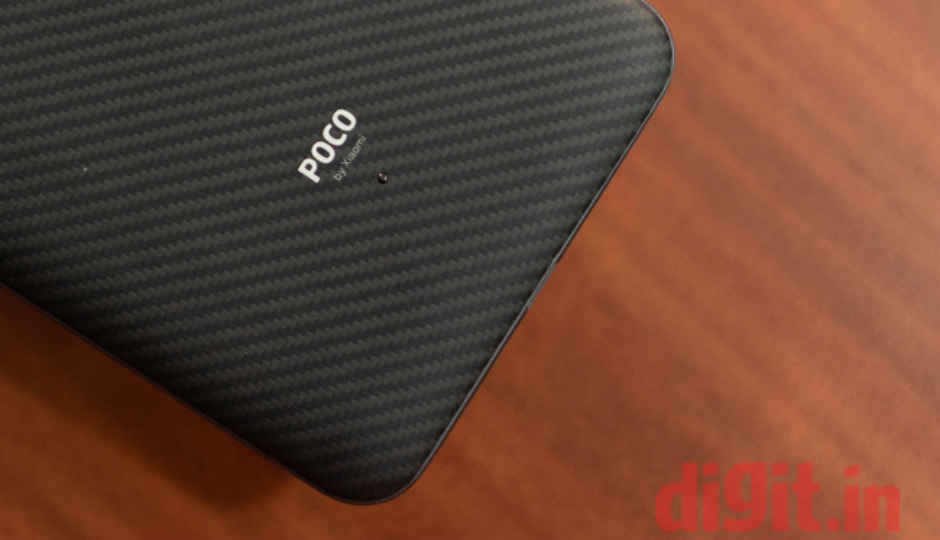 Highlights: Poco F1 is now receiving the Widevine L1 certificate via a MIUI Beta OTA update. The DRM certificate will allow Poco F1 users to stream content in HD. However, the phone reportedly still can't stream HD content on Netflix. Standing true to its words, Xiaomi’s POCO F1 will soon receive the Widevine L1 certification via an OTA update. The certification is presently being rolled out via a MIUI Beta update to Poco F1 users who have signed up for the Beta program. With the Widevine L1 certification, Poco F1 users will be able to stream premium content in HD resolution. However, even after the update, the HD streaming is restricted to Amazon Prime Video and Hotstar. The smartphone is reportedly yet to receive certification for streaming HD content on Netflix. Poco India General Manager, C.Manmohan revealed the news via a Tweet that states — "Guys! You asked for it, we got it. #POCOF1 is now Widevine L1 certified. We have started rolling out an OTA update (version - 9.2.25) for beta users . Once the beta test is complete, we shall roll it in the upcoming stable updates. We really appreciate your patience.” It was earlier assumed the Widevine L1 certification couldn’t be done via an OTA update as the unique key required to enable the feature needed to be installed via a certified PC. However, Google made an update in the way Widevine certification is received have allowed OTA provisioning since the middle of 2017. That was right after the time the OnePlus 5T was asked to be sent to the service center to get the upgraded DRM license. You can read more about how the process works here. However, despite getting the upgraded certificate, the Poco F1 won’t be able to stream HD content on Netflix as Netflix reserves the right to allow devices to stream in HD, despite having the required Widevine L1 certification. The update will be pushed out to all the users, once the beta testing of the feature is complete, according to POCO. Presently, the Poco F1 has Widevine L3 which only allows streaming in 540p on Hotstar, Amazon Prime Video and Netflix. Related Reads: Poco F1 is not the only smartphone to block HD streaming, no Xiaomi device can stream Netflix in HD
Highlights: Poco F1 is now receiving the Widevine L1 certificate via a MIUI Beta OTA update. The DRM certificate will allow Poco F1 users to stream content in HD. However, the phone reportedly still can't stream HD content on Netflix. Standing true to its words, Xiaomi’s POCO F1 will soon receive the Widevine L1 certification via an OTA update. The certification is presently being rolled out via a MIUI Beta update to Poco F1 users who have signed up for the Beta program. With the Widevine L1 certification, Poco F1 users will be able to stream premium content in HD resolution. However, even after the update, the HD streaming is restricted to Amazon Prime Video and Hotstar. The smartphone is reportedly yet to receive certification for streaming HD content on Netflix. Poco India General Manager, C.Manmohan revealed the news via a Tweet that states — "Guys! You asked for it, we got it. #POCOF1 is now Widevine L1 certified. We have started rolling out an OTA update (version - 9.2.25) for beta users . Once the beta test is complete, we shall roll it in the upcoming stable updates. We really appreciate your patience.” It was earlier assumed the Widevine L1 certification couldn’t be done via an OTA update as the unique key required to enable the feature needed to be installed via a certified PC. However, Google made an update in the way Widevine certification is received have allowed OTA provisioning since the middle of 2017. That was right after the time the OnePlus 5T was asked to be sent to the service center to get the upgraded DRM license. You can read more about how the process works here. However, despite getting the upgraded certificate, the Poco F1 won’t be able to stream HD content on Netflix as Netflix reserves the right to allow devices to stream in HD, despite having the required Widevine L1 certification. The update will be pushed out to all the users, once the beta testing of the feature is complete, according to POCO. Presently, the Poco F1 has Widevine L3 which only allows streaming in 540p on Hotstar, Amazon Prime Video and Netflix. Related Reads: Poco F1 is not the only smartphone to block HD streaming, no Xiaomi device can stream Netflix in HD Highlights: Google Duo is now available on the web It gets the Knock Knock feature we see on the phone If you’re an ardent user of Google Duo, you’ve got some good news coming your way. We reported exactly a month ago that the popular video-calling app for Android and iOS platforms would get a web version in a few weeks’ time, and there we go: Google Duo for web is currently available on duo.google.com to both new and existing users alike. Though the site seems to be live when accessed from India, Google admits that “Duo for web is not available in all countries.” According to Google’s help article on setting up Google Duo, the web app works on all computers including Chromebooks. Supported browsers include Google Chrome (quite obviously), Mozilla Firefox, and Apple Safari. Empirical evidence tells us that Microsoft Edge is not a supported browser. We can’t say for sure if Google has omitted Edge support on purpose. Let’s not forget that Microsoft asks you to reconsider when you try to switch your default browser from Edge to Chrome on Windows 10. Interestingly, when the Google Duo site is opened on the latest version of Chrome, expanding the 'More' menu from the right side of the address bar reveals a list item called Install Google Duo... Clicking on it creates a new dedicated window for the web app while placing a shortcut to it in Chrome's Apps list. Though Google Duo is finally on the web, it still needs a valid mobile phone number to work, unlike Google Hangouts, which only needs an active Google account. A new Google Duo user will have to submit a code sent to their mobile phone via SMS to get started on the service. Like its iOS and Android counterparts, Google Duo for web gets features like Knock Knock, which lets recipients see a live video preview of their caller before they answer the call. When rumours about Google shutting down Hangouts for good flooded the internet in December last year, Google was quick to clarify. The search engine giant assured everybody that it would upgrade Hangouts users to Hangouts Chat and Hangouts Meet, two separate G Suite products, before sunsetting the long-standing app. Though Hangouts Chat is currently for G Suite accounts, Google will make it available on regular Google accounts in the coming months. Related Read: Google Hangouts won't shut down, users will be upgraded to Hangouts Chat and Meet
Highlights: Google Duo is now available on the web It gets the Knock Knock feature we see on the phone If you’re an ardent user of Google Duo, you’ve got some good news coming your way. We reported exactly a month ago that the popular video-calling app for Android and iOS platforms would get a web version in a few weeks’ time, and there we go: Google Duo for web is currently available on duo.google.com to both new and existing users alike. Though the site seems to be live when accessed from India, Google admits that “Duo for web is not available in all countries.” According to Google’s help article on setting up Google Duo, the web app works on all computers including Chromebooks. Supported browsers include Google Chrome (quite obviously), Mozilla Firefox, and Apple Safari. Empirical evidence tells us that Microsoft Edge is not a supported browser. We can’t say for sure if Google has omitted Edge support on purpose. Let’s not forget that Microsoft asks you to reconsider when you try to switch your default browser from Edge to Chrome on Windows 10. Interestingly, when the Google Duo site is opened on the latest version of Chrome, expanding the 'More' menu from the right side of the address bar reveals a list item called Install Google Duo... Clicking on it creates a new dedicated window for the web app while placing a shortcut to it in Chrome's Apps list. Though Google Duo is finally on the web, it still needs a valid mobile phone number to work, unlike Google Hangouts, which only needs an active Google account. A new Google Duo user will have to submit a code sent to their mobile phone via SMS to get started on the service. Like its iOS and Android counterparts, Google Duo for web gets features like Knock Knock, which lets recipients see a live video preview of their caller before they answer the call. When rumours about Google shutting down Hangouts for good flooded the internet in December last year, Google was quick to clarify. The search engine giant assured everybody that it would upgrade Hangouts users to Hangouts Chat and Hangouts Meet, two separate G Suite products, before sunsetting the long-standing app. Though Hangouts Chat is currently for G Suite accounts, Google will make it available on regular Google accounts in the coming months. Related Read: Google Hangouts won't shut down, users will be upgraded to Hangouts Chat and Meet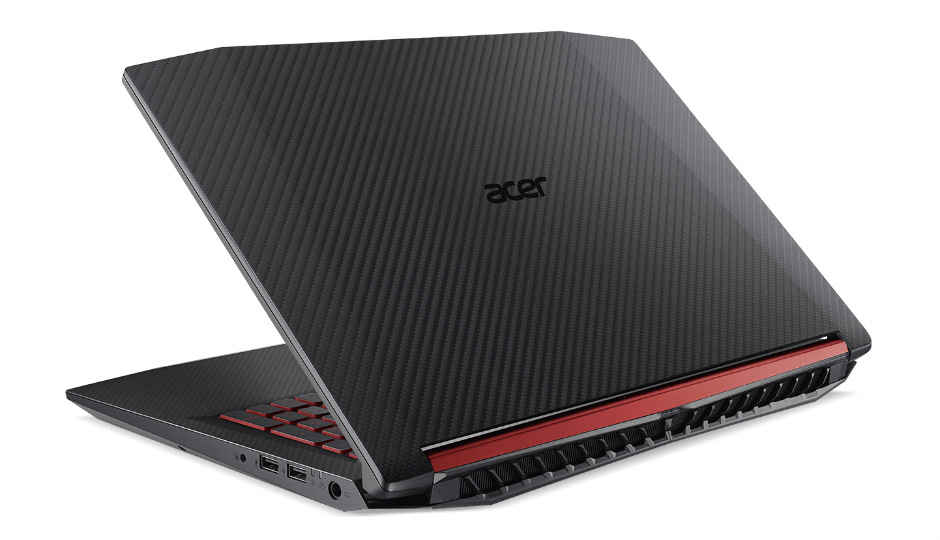 As per IDC Asia Pacific Quarterly Personal Computing Devices Tracker, February 2019 release, Acer is has been the top PC gaming laptop brand in India throughout 2018. This is with respect to unit shipments. The company claims it was able to do so with its Predator and Nitro gaming series of devices, along with its portfolio of PC gaming products that encompasses laptops, desktops, monitors and accessories. Read the complete press release below Acer, one of the world’s leading gaming PC makers has successfully retained its spot of being the “No.1 PC Gaming Laptop Brand” in India throughout 2018, as per leading research firm. Acer gained the top spot in the gaming market with its critically acclaimed and widely popular Predator and Nitro gaming series. Acer in India has the widest portfolio of PC gaming products which includes laptops, desktops, monitors and accessories specifically designed for beginners to professional gamers. Acer has maintained the No. 1 position for 2018 w.r.t unit shipments. Commenting on the achievement, Mr. Chandrahas Panigrahi, CMO & Consumer Business Head, Acer said, “We are extremely delighted to have successfully maintained the No.1 position in the gaming laptop category. Acer has always been committed towards developing remarkable gaming notebooks, desktops and monitors which caters to specific needs of a gamer while also developing the entire ecosystem to support the growth of gaming in India.” Acer ended Q4 2018 with a dominating 41.05% marketing share and rounded of 2018 with 34.2% marketing share to gain No.1 spot as per IDC Asia Pacific Quarterly Personal Computing Devices Tracker, February 2019 release. Acer has been working towards building strong foothold in the Indian gaming industry. The company has achieved many milestones in gaming by launching an array of innovative gaming products like Predator 21X -World’s first curved Screen Gaming laptop, Predator Triton 700- Ultra-thin Gaming Notebook, the gargantuan Thronos gaming cave and other high-end gaming accessories, Predator gaming monitors and more. To add to this growing gaming fever in the country, Acer also organized Asia’s largest DOTA2 and PUBG gaming tournament – The Asia Pacific Predator League to encourage the budding e-sports players in India. Acer’s objective is to grow the gaming market holistically by supporting the industry through cutting-edge products, training and professional e-sports event. *Source: IDC Asia Pacific Quarterly Personal Computing Devices Tracker, February 2019 release.
As per IDC Asia Pacific Quarterly Personal Computing Devices Tracker, February 2019 release, Acer is has been the top PC gaming laptop brand in India throughout 2018. This is with respect to unit shipments. The company claims it was able to do so with its Predator and Nitro gaming series of devices, along with its portfolio of PC gaming products that encompasses laptops, desktops, monitors and accessories. Read the complete press release below Acer, one of the world’s leading gaming PC makers has successfully retained its spot of being the “No.1 PC Gaming Laptop Brand” in India throughout 2018, as per leading research firm. Acer gained the top spot in the gaming market with its critically acclaimed and widely popular Predator and Nitro gaming series. Acer in India has the widest portfolio of PC gaming products which includes laptops, desktops, monitors and accessories specifically designed for beginners to professional gamers. Acer has maintained the No. 1 position for 2018 w.r.t unit shipments. Commenting on the achievement, Mr. Chandrahas Panigrahi, CMO & Consumer Business Head, Acer said, “We are extremely delighted to have successfully maintained the No.1 position in the gaming laptop category. Acer has always been committed towards developing remarkable gaming notebooks, desktops and monitors which caters to specific needs of a gamer while also developing the entire ecosystem to support the growth of gaming in India.” Acer ended Q4 2018 with a dominating 41.05% marketing share and rounded of 2018 with 34.2% marketing share to gain No.1 spot as per IDC Asia Pacific Quarterly Personal Computing Devices Tracker, February 2019 release. Acer has been working towards building strong foothold in the Indian gaming industry. The company has achieved many milestones in gaming by launching an array of innovative gaming products like Predator 21X -World’s first curved Screen Gaming laptop, Predator Triton 700- Ultra-thin Gaming Notebook, the gargantuan Thronos gaming cave and other high-end gaming accessories, Predator gaming monitors and more. To add to this growing gaming fever in the country, Acer also organized Asia’s largest DOTA2 and PUBG gaming tournament – The Asia Pacific Predator League to encourage the budding e-sports players in India. Acer’s objective is to grow the gaming market holistically by supporting the industry through cutting-edge products, training and professional e-sports event. *Source: IDC Asia Pacific Quarterly Personal Computing Devices Tracker, February 2019 release. 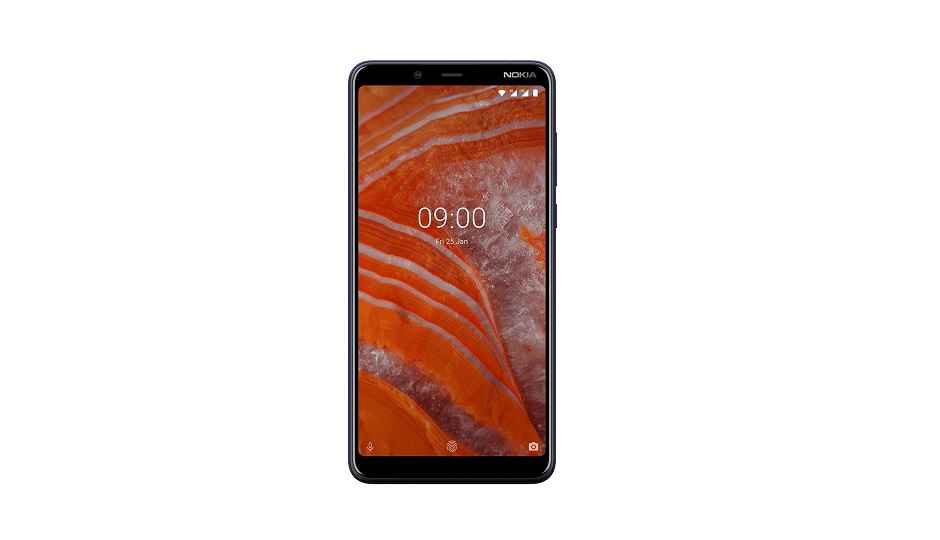 Highlights: Nokia 3.1 Plus is now receiving the Android 9 Pie update The update was supposed to arrive in January The Nokia 3.1 Plus is finally getting its fair share of the pie. According to a tweet sent out by Juho Sarvikas, HMD Global’s Chief Product Officer yesterday, Android 9 Pie is rolling out to the Nokia 3.1 Plus. Users of the phone can expect to see an update notification pop up in the coming days. The budget-friendly Nokia 3.1 Plus joins the company’s previous flagship smartphone, the Nokia 8 Sirocco, which got its Pie update only last month. If we compare the actual delivery date of the Nokia 3.1 Plus’ Android Pie update with Nokia’s update roadmap, which Sarvikas published on Twitter in January, we’ll see that the Finnish smartphone company is a whole month behind on schedule. The roadmap claims to bring the Pie update to the Nokia 3.1 Plus in “January 2019”. Clearly, that’s not the case. Smartphones still waiting to be updated in Nokia’s stable include the Nokia 3 and the Nokia 1. The Nokia 2.1 received its Android Pie update just five days ago. Along with the Go Edition of Android 9 Pie, the smartphone received the February 2019 security patch and 500 megabytes of additional storage with the claim of reduced boot time. The Nokia 1, of course, will be also receiving the Go Edition of the software. However, we’re not sure if it too will get some additional storage space. The Nokia 3.1 Plus, which has been in the Indian smartphone market since October 2018, is powered by a MediaTek Helio P22 chipset and 3GB of RAM. Storage is 32GB with an option to expand it up to 400GB. The Nokia 3.1 Plus has a 6-inch HD+ display with an 18:9 aspect ratio. The rear of the phone sports a dual camera (13-megapixel + 5-megapixel) and the front has a single 8-megapixel selfie shooter. The battery on it is a 3,500mAh unit. The Nokia 3.1 Plus costs Rs 9,999, according to the official website. Related Read: Nokia 2.1 gets February security patch, up to 500MB additional storage with Android 9 Pie (Go Edition) update The wait is over! Get ready to feast on a sweeter smartphone experience with Android 9 Pie on Nokia 3.1 Plus. Nokia smartphones get smarter with time #GetSmart #Nokiamobile pic.twitter.com/8wG544OAEk — Juho Sarvikas (@sarvikas) 26 February 2019
Highlights: Nokia 3.1 Plus is now receiving the Android 9 Pie update The update was supposed to arrive in January The Nokia 3.1 Plus is finally getting its fair share of the pie. According to a tweet sent out by Juho Sarvikas, HMD Global’s Chief Product Officer yesterday, Android 9 Pie is rolling out to the Nokia 3.1 Plus. Users of the phone can expect to see an update notification pop up in the coming days. The budget-friendly Nokia 3.1 Plus joins the company’s previous flagship smartphone, the Nokia 8 Sirocco, which got its Pie update only last month. If we compare the actual delivery date of the Nokia 3.1 Plus’ Android Pie update with Nokia’s update roadmap, which Sarvikas published on Twitter in January, we’ll see that the Finnish smartphone company is a whole month behind on schedule. The roadmap claims to bring the Pie update to the Nokia 3.1 Plus in “January 2019”. Clearly, that’s not the case. Smartphones still waiting to be updated in Nokia’s stable include the Nokia 3 and the Nokia 1. The Nokia 2.1 received its Android Pie update just five days ago. Along with the Go Edition of Android 9 Pie, the smartphone received the February 2019 security patch and 500 megabytes of additional storage with the claim of reduced boot time. The Nokia 1, of course, will be also receiving the Go Edition of the software. However, we’re not sure if it too will get some additional storage space. The Nokia 3.1 Plus, which has been in the Indian smartphone market since October 2018, is powered by a MediaTek Helio P22 chipset and 3GB of RAM. Storage is 32GB with an option to expand it up to 400GB. The Nokia 3.1 Plus has a 6-inch HD+ display with an 18:9 aspect ratio. The rear of the phone sports a dual camera (13-megapixel + 5-megapixel) and the front has a single 8-megapixel selfie shooter. The battery on it is a 3,500mAh unit. The Nokia 3.1 Plus costs Rs 9,999, according to the official website. Related Read: Nokia 2.1 gets February security patch, up to 500MB additional storage with Android 9 Pie (Go Edition) update The wait is over! Get ready to feast on a sweeter smartphone experience with Android 9 Pie on Nokia 3.1 Plus. Nokia smartphones get smarter with time #GetSmart #Nokiamobile pic.twitter.com/8wG544OAEk — Juho Sarvikas (@sarvikas) 26 February 2019 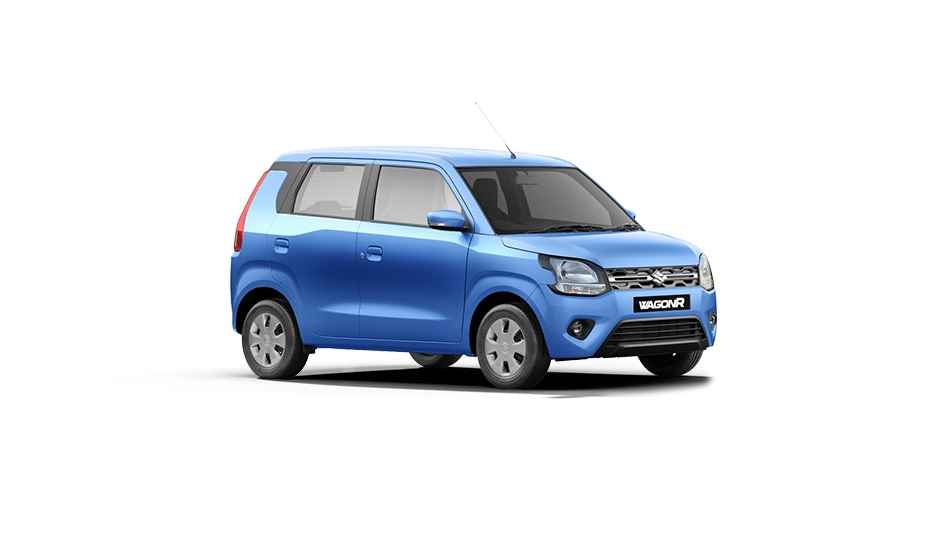 Highlights: Maruti Suzuki Wagon R EV will come with DC fast charging support It will charge the EV up by 80 percent in under one hour The Wagon R EV is expected to be launched in India by 2020 By now, the theory that Maruti Suzuki will launch an electric version of the popular tallboy Wagon R for the Indian market sometime in 2020 is fairly well established. According to numerous reports, the car maker currently has a fleet of fifty Wagon R EVs on test across the country. According to a fresh report by Autocar India, the car will support DC fast charging, in addition to AC charging, thereby decreasing the EV’s charging time considerably. If the information from Autocar India’s report is correct, the DC fast charging feature will juice up the Wagon R by 80 percent in just under an hour, while the regular AC charging will take 7 hours to complete. Images leaked so far of the Wagon R EV reveal two different charging ports on the car’s body: the AC charging port in the front and the DC fast charging port in the rear. With the convenience of fast charging, it’s not hard to imagine Indian cities quickly filling up with Wagon R EV taxis. Autocar India says that the Wagon Rs seen in the spy images are prototypes and that the final version of the car will look different. In fact, it’s possible the final version of the Wagon R EV greatly resembles the outgoing petrol-powered model. That’s because Maruti may not want to invest too much in redesigning the car when the big task at hand is to create an EV for the masses. So, the only thing different about the Wagon R EV could be its powertrain (and the price). Maruti Suzuki launched a new generation of its popular Wagon R only last month at a starting price of Rs 4.19 lakh. Unlike the previous generation, which was powered solely by Maruti’s 1.0-litre K10 series engine, the new generation comes with an extra engine option: the bigger 1.2-litre K12 series engine that powers larger models like the Baleno and Swift. There’s no word yet on how much the new Wagon R EV will cost when it launches next year but sources say it could be priced under Rs 7 lakh. We’ll keep our fingers crossed until then. Inline image courtesy: Autocar India Related Read: Apple's Project Titan electric car could actually be a van
Highlights: Maruti Suzuki Wagon R EV will come with DC fast charging support It will charge the EV up by 80 percent in under one hour The Wagon R EV is expected to be launched in India by 2020 By now, the theory that Maruti Suzuki will launch an electric version of the popular tallboy Wagon R for the Indian market sometime in 2020 is fairly well established. According to numerous reports, the car maker currently has a fleet of fifty Wagon R EVs on test across the country. According to a fresh report by Autocar India, the car will support DC fast charging, in addition to AC charging, thereby decreasing the EV’s charging time considerably. If the information from Autocar India’s report is correct, the DC fast charging feature will juice up the Wagon R by 80 percent in just under an hour, while the regular AC charging will take 7 hours to complete. Images leaked so far of the Wagon R EV reveal two different charging ports on the car’s body: the AC charging port in the front and the DC fast charging port in the rear. With the convenience of fast charging, it’s not hard to imagine Indian cities quickly filling up with Wagon R EV taxis. Autocar India says that the Wagon Rs seen in the spy images are prototypes and that the final version of the car will look different. In fact, it’s possible the final version of the Wagon R EV greatly resembles the outgoing petrol-powered model. That’s because Maruti may not want to invest too much in redesigning the car when the big task at hand is to create an EV for the masses. So, the only thing different about the Wagon R EV could be its powertrain (and the price). Maruti Suzuki launched a new generation of its popular Wagon R only last month at a starting price of Rs 4.19 lakh. Unlike the previous generation, which was powered solely by Maruti’s 1.0-litre K10 series engine, the new generation comes with an extra engine option: the bigger 1.2-litre K12 series engine that powers larger models like the Baleno and Swift. There’s no word yet on how much the new Wagon R EV will cost when it launches next year but sources say it could be priced under Rs 7 lakh. We’ll keep our fingers crossed until then. Inline image courtesy: Autocar India Related Read: Apple's Project Titan electric car could actually be a van